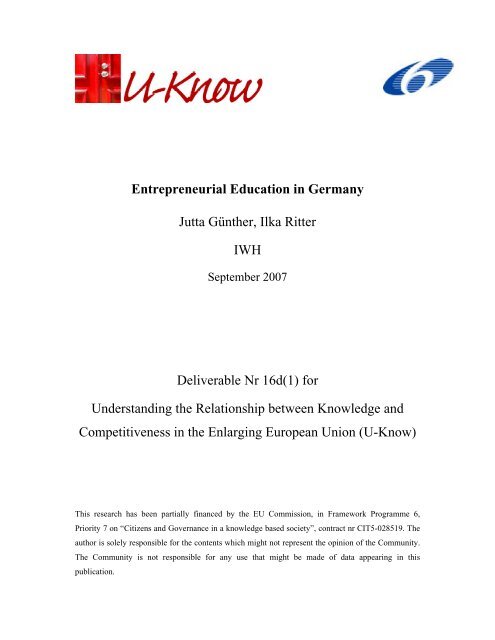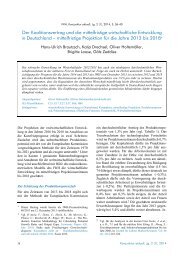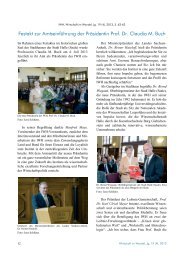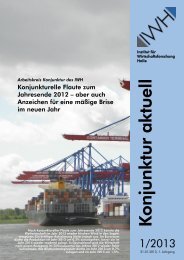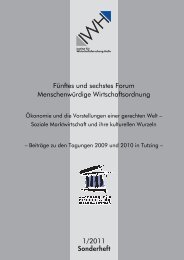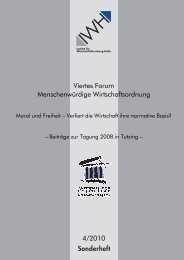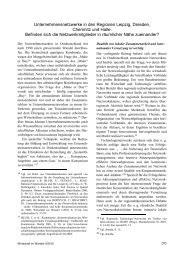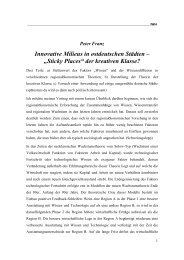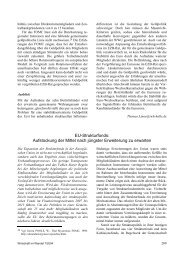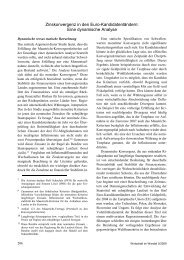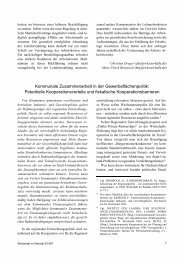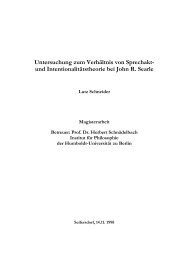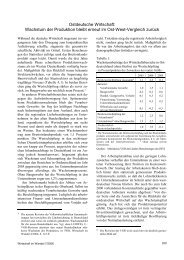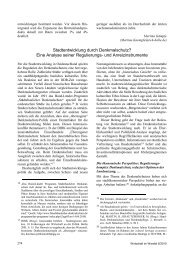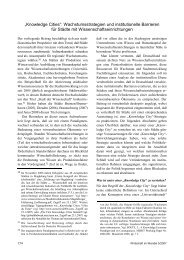Entrepreneurial Education in Germany Jutta Günther, Ilka Ritter IWH ...
Entrepreneurial Education in Germany Jutta Günther, Ilka Ritter IWH ...
Entrepreneurial Education in Germany Jutta Günther, Ilka Ritter IWH ...
Create successful ePaper yourself
Turn your PDF publications into a flip-book with our unique Google optimized e-Paper software.
<strong>Entrepreneurial</strong> <strong>Education</strong> <strong>in</strong> <strong>Germany</strong><br />
<strong>Jutta</strong> <strong>Günther</strong>, <strong>Ilka</strong> <strong>Ritter</strong><br />
<strong>IWH</strong><br />
September 2007<br />
Deliverable Nr 16d(1) for<br />
Understand<strong>in</strong>g the Relationship between Knowledge and<br />
Competitiveness <strong>in</strong> the Enlarg<strong>in</strong>g European Union (U-Know)<br />
This research has been partially f<strong>in</strong>anced by the EU Commission, <strong>in</strong> Framework Programme 6,<br />
Priority 7 on “Citizens and Governance <strong>in</strong> a knowledge based society”, contract nr CIT5-028519. The<br />
author is solely responsible for the contents which might not represent the op<strong>in</strong>ion of the Community.<br />
The Community is not responsible for any use that might be made of data appear<strong>in</strong>g <strong>in</strong> this<br />
publication.
<strong>Entrepreneurial</strong> <strong>Education</strong> <strong>in</strong> <strong>Germany</strong><br />
Table of Contents<br />
<strong>Entrepreneurial</strong> <strong>Education</strong> <strong>in</strong> <strong>Germany</strong>...................................................................................... 2<br />
1. Introduction ............................................................................................................................ 3<br />
2. Characteristics of HEI provid<strong>in</strong>g entrepreneurial education.................................................. 4<br />
2.1. General characteristics of the HEI .................................................................................. 4<br />
2.2. Entrepreneurship chairs................................................................................................... 5<br />
3. Courses on entrepreneurial education at German HEI........................................................... 8<br />
4. <strong>Entrepreneurial</strong> education and the science-<strong>in</strong>dustry l<strong>in</strong>k ..................................................... 11<br />
4.1. Commercialization and entrepreneurship <strong>in</strong> the HEI mission statements..................... 11<br />
4.2. Infrastructure and services of the HEI for knowledge commercialization.................... 12<br />
4.3. Co-operation (chairs – <strong>in</strong>frastructure) and f<strong>in</strong>anc<strong>in</strong>g of “Gründungsberatung” ........... 14<br />
5. Special topic: East <strong>Germany</strong> ................................................................................................ 16<br />
6. Case studies .......................................................................................................................... 16<br />
6.1. Leuphana University Lüneburg..................................................................................... 16<br />
6.2. University of Potsdam................................................................................................... 22<br />
6.3. FH Bonn-Rhe<strong>in</strong> Sieg ..................................................................................................... 26<br />
7. Summary .............................................................................................................................. 30<br />
2
1. Introduction<br />
<strong>Entrepreneurial</strong> education is becom<strong>in</strong>g more and more important for higher education<br />
<strong>in</strong>stitutions (HEI) <strong>in</strong> <strong>Germany</strong> s<strong>in</strong>ce the 1980s. Before, entrepreneurial education was hardly<br />
available. If at all it was carried out by chambers of commerce, professional associations etc.<br />
But s<strong>in</strong>ce the 1980s, academia has discovered the field, and universities as well as universities<br />
of applied sciences (Fachhochschulen) provide an <strong>in</strong>creas<strong>in</strong>g number of courses on<br />
entrepreneurship. F<strong>in</strong>ally, the first chair for entrepreneurship was established <strong>in</strong> <strong>Germany</strong> <strong>in</strong><br />
1997. Today, more than 50 active entrepreneurship chairs exist at German higher education<br />
<strong>in</strong>stitutions.<br />
An important organization for research on entrepreneurial education <strong>in</strong> <strong>Germany</strong> is the<br />
Förderkreis Gründungsforschung e.V. (Society for the Promotion of Entrepreneurship<br />
Research, FGF). The FGF, besides other activities, runs a periodic survey on entrepreneurship<br />
chairs <strong>in</strong> <strong>Germany</strong> (s<strong>in</strong>ce 1998).<br />
One major challenge as regards the implementation of a survey for <strong>Germany</strong> is the very dense<br />
network of higher education <strong>in</strong>stitutions. In <strong>Germany</strong>, accord<strong>in</strong>g to the Federal Statistical<br />
Office, <strong>in</strong> 2006/07 exist 383 higher education <strong>in</strong>stitutions. 1 It would have been impossible<br />
with<strong>in</strong> the scope of this project to screen such a large number of <strong>in</strong>stitutions from scratch. In<br />
order to keep th<strong>in</strong>gs feasible, and <strong>in</strong> order to make use of exist<strong>in</strong>g survey material, we took<br />
the FGF database on entrepreneurship chairs as a start<strong>in</strong>g po<strong>in</strong>t. The FGF has a list of<br />
entrepreneurship chairs (active chairs, vacant chairs, planned chairs). We restricted our survey<br />
to those higher education <strong>in</strong>stitutions which have at least one actively operat<strong>in</strong>g<br />
entrepreneurship chair (HEI with vacant and planned chairs hardly offer <strong>in</strong>formation on<br />
courses, target group etc.). Our decision to <strong>in</strong>clude only HEI with an active entrepreneurship<br />
chair is of course a pragmatic approach, and one has to be aware that there exist HEI<br />
provid<strong>in</strong>g courses <strong>in</strong> the field of entrepreneurship, but not hav<strong>in</strong>g an entrepreneurship chair. 2<br />
At the time we run the survey (March – April 2007), we identified 49 higher education<br />
<strong>in</strong>stitutions (HEI) with at least one actively operat<strong>in</strong>g entrepreneurship chair. We took these<br />
HEI from the FGF list of entrepreneurship chairs (see www.fgf-ev.de; Map of<br />
Entrepreneurship Chairs). 3 We greatly thank the FGF for support and cooperation. From the<br />
FGF we also obta<strong>in</strong>ed data on the “faculty” to which the chair belongs, on the chair’s<br />
1 Source: http://www.destatis.de/basis/d/biwiku/hochtab1.php; The number of 383 <strong>in</strong>cludes 6 teacher tra<strong>in</strong><strong>in</strong>g<br />
colleges (Pädagogische Hochschulen), 15 colleges of theology (Theologische Hochschulen), and 53 colleges of<br />
art (Kunsthochschulen). So, even if we would exclude them, the number rema<strong>in</strong>s very high.<br />
2 The FGF offers a list of more than 30 so-called “entrepreneurship-affiliated” chairs, but this is explicitly an<br />
exemplary and selective list. The recent publication of Achleitner et al. (2007) identifies 45 entrepreneushipaffiliated<br />
chairs <strong>in</strong> <strong>Germany</strong>. However, it rema<strong>in</strong>s difficult to generate a reliable list of HEI provid<strong>in</strong>g<br />
entrepreneurial education <strong>in</strong> <strong>Germany</strong>.<br />
3<br />
We excluded those HEI where an exist<strong>in</strong>g entrepreneurship chair is vacant and those where an entrepreneurship<br />
chair is planned, but not yet realized.<br />
3
“scientific specialization”, and on the “target group”, i.e. whether the entrepreneurship<br />
teach<strong>in</strong>g is aimed to educate future entrepreneurs or future entrepreneurship researchers. In<br />
addition to this, we collected the follow<strong>in</strong>g <strong>in</strong>formation via Internet, Email contact, and phone<br />
calls.<br />
2. Characteristics of HEI provid<strong>in</strong>g entrepreneurial education<br />
2.1. General characteristics of the HEI<br />
As mentioned above, we <strong>in</strong>cluded 49 HEI <strong>in</strong> the survey of which seven are private, stateapproved<br />
HEI. Among them, we identified different types (universities, technical universities,<br />
universities of applied sciences, and bus<strong>in</strong>ess schools). 4 The majority of HEI deal<strong>in</strong>g with<br />
entrepreneurial education falls <strong>in</strong>to the category of universities of applied sciences (25),<br />
followed by universities (18) of which one is an open university (Fernuniversität Hagen).<br />
There are four technical universities and two “bus<strong>in</strong>ess schools” <strong>in</strong> our data set. Bus<strong>in</strong>ess<br />
Schools are not subject to official statistics <strong>in</strong> <strong>Germany</strong>. In <strong>Germany</strong>, the official statistics<br />
dist<strong>in</strong>guish the follow<strong>in</strong>g types of HEI: Universities (Universitäten), Universities of Applied<br />
Sciences (Fachhochschulen), Teacher Tra<strong>in</strong><strong>in</strong>g Colleges (Pädagogische Hochschulen),<br />
Colleges of Theology (Theologische Hochschulen), and Colleges of Art (Kunsthochschulen).<br />
Figure 1 Overview of HEI <strong>in</strong> <strong>Germany</strong> 2006/2007 1<br />
Universities<br />
(<strong>in</strong>cl. 4 Technical Universities, TU)<br />
Total<br />
number of<br />
HEI*<br />
Students enrolled<br />
2006/2007*<br />
4<br />
Number of HEI with<br />
entrepreneurship<br />
education<br />
103 1,372,893 22<br />
(<strong>in</strong>cl. 4 TU)<br />
Universities of Applied Sciences 206 570,712 25<br />
*refers to official statistics (Federal Statistical Office of <strong>Germany</strong>), 2006/2007.<br />
1<br />
Exclud<strong>in</strong>g teacher tra<strong>in</strong><strong>in</strong>g colleges (Pädagogische Hochschulen), Colleges of Theology (Theologische<br />
Hochschulen), and Colleges of Art (Kunsthochschulen).<br />
There are HEI of very different age <strong>in</strong> our sample. The oldest HEI was founded <strong>in</strong> 1472<br />
(Ludwig-Maximilians University München) and the youngest <strong>in</strong> 2003 (Zeppel<strong>in</strong> University –a<br />
small private university) 5 . Overall, ten HEI were founded between 1472 and 1900, 16 were<br />
4 We def<strong>in</strong>e a “bus<strong>in</strong>ess school” as an <strong>in</strong>dependent HEI offer<strong>in</strong>g programs solely or predom<strong>in</strong>antly <strong>in</strong> the field of<br />
bus<strong>in</strong>ess adm<strong>in</strong>istration. In general, there do not (yet) exist many bus<strong>in</strong>ess schools <strong>in</strong> <strong>Germany</strong>. In some cases it<br />
was not obvious whether a HEI is bus<strong>in</strong>ess school, a university or a university of applied sciences. In case of<br />
doubt, we <strong>in</strong>terviewed the relevant HEI and asked which category they would ascribe themselves to.<br />
5<br />
University of Duisburg-Essen was also created <strong>in</strong> 2003, but it was a fusion of two exist<strong>in</strong>g universities <strong>in</strong><br />
North-Rh<strong>in</strong>e Westphalia (Ruhrgebiet).
founded between 1901 and 1990. The largest group (23 HEI) are rather young HEI, founded<br />
after 1990, among them many universities of applied sciences (18). One might expect that the<br />
majority of these 23 HEI were founded <strong>in</strong> the Eastern part of <strong>Germany</strong>, but only 10 of theses<br />
young HEI are located <strong>in</strong> the Eastern part of the country.<br />
The size of the HEI <strong>in</strong> our sample, expressed as total number of students enrolled <strong>in</strong> the<br />
w<strong>in</strong>ter term 2006-2007, varies between 300 and 47,500. In the group of small HEI (12) with<br />
up to 3,000 students are many private schools (<strong>in</strong>clud<strong>in</strong>g the two bus<strong>in</strong>ess schools) with few<br />
but specialized programs, often <strong>in</strong> the field of bus<strong>in</strong>ess, economics, and <strong>in</strong>formation<br />
technology – of course <strong>in</strong>clud<strong>in</strong>g aspects of entrepreneurship. One third of the HEI <strong>in</strong> our<br />
sample (16) are medium sized with more than 3000 and up to 10,000 students. In this group<br />
only one HEI is a university, the rest are universities of applied sciences. F<strong>in</strong>ally, there are<br />
many large HEI <strong>in</strong> our data set (21) with more than 10,000 students enrolled. In this category<br />
we f<strong>in</strong>d predom<strong>in</strong>antly universities, technical universities (all three), and only two universities<br />
of applied sciences.<br />
Figure 2 General characteristics of HEI<br />
Formation of University (HEI) Number of enrolled students<br />
Source: <strong>IWH</strong><br />
Frequency Percentage Frequency Percentage<br />
Until 1900 10 20,4% Up to 3000 12 24,5%<br />
1901 - 1990 16 32,7% 3001 - 10000 16 32,7%<br />
After 1990 23 46,9% Above 10000 21 42,9%<br />
Total 49 100,0% Total 49 100,0%<br />
2.2. Entrepreneurship chairs<br />
Together, the 49 HEI <strong>in</strong> our survey have 54 active entrepreneurship chairs. 6 Only five of<br />
the professors are women (9%), which is fairly below the already low share of female<br />
professors <strong>in</strong> <strong>Germany</strong> (14% on average). 7<br />
Nearly half of the entrepreneurship chairs (25) are “Stiftungsprofessuren”.<br />
“Stiftungprofessur” means that a newly established professorship is <strong>in</strong>itially f<strong>in</strong>anced<br />
externally (not by the HEI), for example through a company, a foundation, or other private or<br />
6 In two cases the entrepreneurship chair is a Honorarprofessor (honorary professor). Honorary professor is a<br />
title awarded to people that have given lectures at a particular university for several years while work<strong>in</strong>g<br />
somewhere else (they usually give one lecture or sem<strong>in</strong>ar each semester).<br />
7 http://www.bmbf.de/pub/zukunftswerkstatt_deutschland.pdf<br />
5
public organizations. Commonly, the agreement between the HEI and the founder places the<br />
full f<strong>in</strong>anc<strong>in</strong>g responsibility for the chair on the part of the HEI after a period of five years. In<br />
our sample, for example three chairs are f<strong>in</strong>anced by the Kreditanstalt für Wiederaufbau<br />
(KfW), one is an SAP professorship etc.<br />
The entrepreneurship chairs have teams of different size, rang<strong>in</strong>g from 1 to 12 people<br />
(scientific staff, <strong>in</strong>clud<strong>in</strong>g the professor). On average, a team consists of 3.5 scientists. Most<br />
teams are rather small groups with up to 3 people (56%). Only 11% of the teams consist of<br />
more than 8 persons.<br />
From previous studies on entrepreneurial education <strong>in</strong> <strong>Germany</strong> (especially the FGF reports)<br />
we know, that the programs and courses are mostly offered <strong>in</strong> a faculty of economics. We can<br />
confirm this through our survey. The vast majority of chairs (43 out of 53) belong to an<br />
economics faculty (economics or bus<strong>in</strong>ess adm<strong>in</strong>istration). The rest belongs to social sciences<br />
(2), computer science (2), eng<strong>in</strong>eer<strong>in</strong>g (3), education sciences (1), natural science (1), and<br />
others (2). 8<br />
Figure 3 Faculty affiliation of entrepreneurship chairs<br />
Faculty affiliation of Entrepreneurship chairs<br />
Source: <strong>IWH</strong><br />
Frequency Percentage<br />
Economics 43 79,6%<br />
Eng<strong>in</strong>eer<strong>in</strong>g sciences 3 5,6%<br />
Computer sciences 2 3,7%<br />
Social sciences 2 3,7%<br />
Pedagogics / education 1 1,9%<br />
Natural sciences 1 1,9%<br />
Others 2 3,7%<br />
Total 54 100,0%<br />
Percentage<br />
90,0%<br />
75,0%<br />
60,0%<br />
45,0%<br />
30,0%<br />
15,0%<br />
0,0%<br />
Faculty Affiliation<br />
Economics<br />
6<br />
Eng<strong>in</strong>eer<strong>in</strong>g Sciences<br />
Computer sciences<br />
Social sciences<br />
Pedagogics / education<br />
Natural sciences<br />
As shown <strong>in</strong> the chart below, the entrepreneurship chairs have different specializations. 9 Not<br />
very surpris<strong>in</strong>g, nearly all chairs stated that they deal with “entrepreneurship <strong>in</strong> general” (over<br />
90%), followed by “<strong>in</strong>novative start-ups” as an important field too. Also frequently mentioned<br />
is the field of “f<strong>in</strong>ance” and “take over / bus<strong>in</strong>ess successor”. In <strong>Germany</strong>, today many small<br />
8<br />
In the case of “Others” we could not identify the faculty because no typical differentiation between faculties<br />
existed at the HEI.<br />
9<br />
We obta<strong>in</strong>ed the figures on “specialization” directly from the FGF (current survey). Note that we <strong>in</strong>cluded only<br />
those chairs which are actively operat<strong>in</strong>g, not those that are planned or vacant. The categories as listed <strong>in</strong> the<br />
chart were given <strong>in</strong> the FGF questionnaire. Multiple answers were possible.<br />
Other
and medium sized firms face <strong>in</strong>creas<strong>in</strong>g difficulties <strong>in</strong> f<strong>in</strong>d<strong>in</strong>g adequate successors for the<br />
firm – possibly a reason for the relatively high priority. Interest<strong>in</strong>gly, the topic of<br />
“<strong>in</strong>trapreneurship” has been mentioned by every second chair as a field they focus on.<br />
Figure 4 Specialization of the entrepreneurship chairs <strong>in</strong> <strong>Germany</strong><br />
Entrepreneurship, general<br />
Innovative start-ups<br />
F<strong>in</strong>ance<br />
Take over, successor<br />
Technology oriented start-ups<br />
Venture capital, Bus<strong>in</strong>ess Angels<br />
Market<strong>in</strong>g<br />
Others<br />
Intrapreneurship<br />
SME<br />
Family bus<strong>in</strong>ess<br />
Psychology of start-ups<br />
Corporate ventur<strong>in</strong>g<br />
Women<br />
Micro orientation<br />
Macro orientation<br />
9<br />
20<br />
26<br />
28<br />
30<br />
39<br />
46<br />
0 10 20 30 40 50 60 70 80 90 100<br />
Source of data: FGF, calculation of the <strong>IWH</strong>; figures refer to the 49 HEI <strong>in</strong>cluded <strong>in</strong> the <strong>IWH</strong> survey.<br />
The target group of entrepreneurial education can be different from the chairs’ perspective.<br />
By target group we dist<strong>in</strong>guish “future entrepreneurs” and “future entrepreneurship<br />
researchers” as addressees. 10 The vast majority of entrepreneurship chairs state that they<br />
<strong>in</strong>tend to educate both, future entrepreneurs as well as future entrepreneurship researchers. 11<br />
chairs said that they focus on entrepreneurs only, and 8 chairs primarily focus on the<br />
education of future entrepreneurship researchers.<br />
10 We obta<strong>in</strong>ed this data directly from the FGF (as <strong>in</strong>formation from their own 2006/2007 survey).<br />
50<br />
52<br />
54<br />
57<br />
59<br />
61<br />
65<br />
74<br />
91<br />
7
3. Courses on entrepreneurial education at German HEI<br />
In this chapter we focus on entrepreneurship related courses offered by the professors of<br />
entrepreneurship. This excludes courses on entrepreneurship offered by other professors<br />
(chairs of entrepreneurship), i.e. the real magnitude of entrepreneurial education is somehow<br />
underestimated here. Overall, the HEI <strong>in</strong>cluded <strong>in</strong> the survey offer 250 entrepreneurship<br />
courses throughout an academic year (summer and w<strong>in</strong>ter term). 11 The number of courses<br />
given by each chair varies strongly (between 1 and 15), of course depend<strong>in</strong>g on the size of the<br />
team. On average, each chair offers 4,8 courses.<br />
The courses naturally vary <strong>in</strong> their time scope. In the German higher education system, this is<br />
usually expressed as “Semesterwochenstunden” (SWS), which means teach<strong>in</strong>g hours per<br />
week dur<strong>in</strong>g the semester. Mostly, a lecture or a sem<strong>in</strong>ar <strong>in</strong> <strong>Germany</strong> is given with two SWS,<br />
sometimes comb<strong>in</strong>ed with an exercise course last<strong>in</strong>g additional two SWS. The majority of<br />
entrepreneurship courses <strong>in</strong> our survey is given with two SWS (56% of all courses). However,<br />
there is also a number of courses which last four SWS (16.8%). The others are taught with 1<br />
or 3 SWS or as so-called “block sem<strong>in</strong>ar”. “Block” means that the course is not given weekly<br />
but conducted <strong>in</strong>tensively over a small number of days, often on weekends.<br />
Naturally, there are different types of <strong>in</strong>struction. We identified “lectures” which are usually<br />
designed for larger groups of students and allow little <strong>in</strong>teraction among participants. There<br />
are “sem<strong>in</strong>ars” which usually require the active participation of students, e.g. <strong>in</strong> the form of<br />
student presentations, group discussions or team work. Furthermore, there are “exercise<br />
courses” where theoretical knowledge is applied aga<strong>in</strong>st real-life situations, and f<strong>in</strong>ally there<br />
exist comb<strong>in</strong>ations out of these types of <strong>in</strong>struction. Regard<strong>in</strong>g entrepreneurship education,<br />
the two most prom<strong>in</strong>ent types are lectures and sem<strong>in</strong>ars, which together make up for around<br />
75.2% of all courses.<br />
Figure 5 Types of <strong>in</strong>struction<br />
Types of <strong>in</strong>struction<br />
Source: <strong>IWH</strong><br />
Frequency Percentage<br />
Lectures 97 38,8%<br />
Sem<strong>in</strong>ars 91 36,4%<br />
Exercise courses 19 7,6%<br />
Comb<strong>in</strong>ations thereof 21 8,4%<br />
Others 10 4,0%<br />
Not announced 12 4,8%<br />
50,0%<br />
40,0%<br />
30,0%<br />
20,0%<br />
10,0%<br />
Total 250 100,0% 0,0%<br />
Percentage<br />
Type of Instruction<br />
Lectures<br />
Sem<strong>in</strong>ars<br />
8<br />
Exercise course<br />
Comb<strong>in</strong>ations<br />
Other<br />
Not announced<br />
11<br />
Courses given by the chairs which deal with other topics (such as <strong>in</strong>novation management and management <strong>in</strong><br />
general) were not <strong>in</strong>cluded <strong>in</strong> the analysis.
The courses have different target groups with respect to the student’s stage of academic<br />
career (advancement). So far, the German university system dist<strong>in</strong>guished between<br />
“Grundstudium” (basic study, usually last<strong>in</strong>g the first four semesters) and “Hauptstudium”<br />
(advanced study, usually last<strong>in</strong>g further 5 to 6 semesters). After 9 to 10 semesters the degree<br />
of “Diplom” or “Magister” is awarded. Today, the differentiation between “Grund- /<br />
Hauptstudium” and the relevant degrees are only valid for programs which have not yet been<br />
transformed <strong>in</strong>to the Bachelor or Master system. Over time, all traditional “Diplom” and<br />
“Magister” programs will phase out <strong>in</strong> favor of Bachelor and Master programs (as agreed <strong>in</strong><br />
the Bologna process <strong>in</strong> 1999). The implementation of the new programs is an ongo<strong>in</strong>g process<br />
<strong>in</strong> <strong>Germany</strong>, and universities still have students enrolled <strong>in</strong> the old as well as <strong>in</strong> the new<br />
programs. Accord<strong>in</strong>gly, for the courses <strong>in</strong>cluded <strong>in</strong> our survey we found different<br />
announcements as regards the target group (“Grundstudium”, “Hauptstudium”, Bachelor,<br />
Master, and comb<strong>in</strong>ations). What is clearly visible form the data collected is that the<br />
entrepreneurship courses are predom<strong>in</strong>antly offered for advanced students; 46.4% have<br />
explicitly been announced for the “Hauptstudium”. 12<br />
Figure 6 Target groups of entrepreneurship courses<br />
Target groups<br />
<strong>in</strong> respect of academic advancement<br />
Source: <strong>IWH</strong><br />
Frequency Percentage<br />
Hauptstudium 116 46,4%<br />
Bachelor 20 8,0%<br />
Master 11 4,4%<br />
Grundstudium 8 3,2%<br />
MBA 5 2,0%<br />
Comb<strong>in</strong>ation 73 29,2%<br />
Not announced 17 6,8%<br />
Total 250 100,0%<br />
Percentage<br />
50,0%<br />
40,0%<br />
30,0%<br />
20,0%<br />
10,0%<br />
0,0%<br />
Target Group<br />
9<br />
Hauptstudium<br />
Bachelor<br />
Master<br />
Grundstudium<br />
MBA<br />
Comb<strong>in</strong>ation<br />
Not announced<br />
In account with the fact that the majority of entrepreneurship chairs belong to economics<br />
departments, the vast majority of courses (86.4%) fall <strong>in</strong>to the category “social sciences,<br />
economics or law studies”. A much smaller number of courses is offered <strong>in</strong> the natural<br />
sciences and eng<strong>in</strong>eer<strong>in</strong>g although the potential for start-ups are particularly high <strong>in</strong> these<br />
fields. However, we do not know how many students form eng<strong>in</strong>eer<strong>in</strong>g or natural sciences<br />
<strong>in</strong>terested <strong>in</strong> an entrepreneurial activity jo<strong>in</strong> courses <strong>in</strong> the economics or social sciences<br />
departments.<br />
12 A PhD study program, comparable for example to the American system, does not exist <strong>in</strong> <strong>Germany</strong>.
Figure 7 Academic categories of entrepreneurship courses<br />
Academic categories<br />
Source: <strong>IWH</strong><br />
Frequency Percentage<br />
Social sciences, economics or law studies 216 86,4%<br />
Natural sciences and eng<strong>in</strong>eer<strong>in</strong>g (<strong>in</strong>clud<strong>in</strong>g computer eng<strong>in</strong>eer<strong>in</strong>g) 23 9,2%<br />
Other 11 4,4%<br />
Total 250 100,0%<br />
In order to get some <strong>in</strong>sight <strong>in</strong>to the content of the courses, we went through the titles and<br />
brief descriptions of all 250 courses, identified groups of related topics and build several<br />
categories accord<strong>in</strong>gly. Afterwards, we assigned courses to these categories<br />
correspond<strong>in</strong>gly. 13<br />
It shows that most courses fall <strong>in</strong>to the group “Introduction to Entrepreneurship/Fundamentals<br />
of Entrepreneurship” (38%). This corresponds to the high priority of “entrepreneurship,<br />
general” expressed as a field of <strong>in</strong>terest by the entrepreneurship chairs (see Figure 4). The<br />
second largest group consists of courses deal<strong>in</strong>g with “bus<strong>in</strong>ess plan development” (26.4%),<br />
<strong>in</strong>clud<strong>in</strong>g the topic of bus<strong>in</strong>ess simulation. Some courses offer deeper <strong>in</strong>sights <strong>in</strong>to particular<br />
aspects related to entrepreneurship, such as “entrepreneurial f<strong>in</strong>ance” (9.6%), “legal aspects”<br />
(4.4%), “market<strong>in</strong>g” (2%). Another group of courses deals with “soft skills” explicitly related<br />
to entrepreneurial activities (8.4%). In the category “other topics” fall courses on e.g.<br />
<strong>in</strong>trapreneurship, entrepreneurial HR management, entrepreneurial growth management and<br />
<strong>in</strong>ternationalization.<br />
As regards the science-<strong>in</strong>dustry relations as part of the teach<strong>in</strong>g program, we found only five<br />
courses deal<strong>in</strong>g explicitly with the topic “commercialization of knowledge and/or<br />
<strong>in</strong>novation”. The course titles are e.g. “IPR and patent<strong>in</strong>g”, “Sp<strong>in</strong>-offs from public research”,<br />
“HEI as an <strong>in</strong>cubator for entrepreneurial activity”. However, one cannot exclude that aspects<br />
like patent<strong>in</strong>g, jo<strong>in</strong>t science-<strong>in</strong>dustry projects etc. are also part of other courses.<br />
13 In face of the fact that we found as much as 250 courses, it was impossible to go through the detailed course<br />
descriptions or schedules themselves.<br />
10
Figure 8 Content of entrepreneurship courses<br />
Content of the course<br />
Source: <strong>IWH</strong><br />
Frequency Percentage<br />
Pr<strong>in</strong>ciples of Entrepreneurship<br />
40,0%<br />
(Introductory courses) 95 38,0%<br />
35,0%<br />
Bus<strong>in</strong>ess plan development 66 26,4%<br />
30,0%<br />
<strong>Entrepreneurial</strong> f<strong>in</strong>ance<br />
Soft skills<br />
24<br />
21<br />
9,6%<br />
8,4%<br />
25,0%<br />
Legal aspects 11 4,4%<br />
20,0%<br />
Commercialisation 5 2,0%<br />
15,0%<br />
Market<strong>in</strong>g<br />
Other topics<br />
5<br />
23<br />
2,0%<br />
9,2%<br />
10,0%<br />
5,0%<br />
Total 250 100,0% 0,0%<br />
Percentage<br />
Content<br />
4. <strong>Entrepreneurial</strong> education and the science-<strong>in</strong>dustry l<strong>in</strong>k<br />
11<br />
Pr<strong>in</strong>ciples of<br />
Entrepreneurship<br />
Bus<strong>in</strong>ess plan<br />
development<br />
<strong>Entrepreneurial</strong> f<strong>in</strong>ance<br />
Soft skills<br />
Legal aspects<br />
Commercialization<br />
Market<strong>in</strong>g<br />
Other topics<br />
Accord<strong>in</strong>g to § 2 (7) of the “Hochschulrahmengesetz” (Framework Law on Higher <strong>Education</strong>)<br />
<strong>in</strong> <strong>Germany</strong>, the HEI have explicitly the task to facilitate the transfer of knowledge and<br />
technology. As a result, many HEI set up special <strong>in</strong>frastructure, e.g. technology transfer<br />
offices, to support the exchange between HEI and <strong>in</strong>dustry. In the context of technology<br />
transfer or more broadly speak<strong>in</strong>g the science-<strong>in</strong>dustry relations, entrepreneurship activities of<br />
the HEI, are one way to facilitate the transfer of knowledge or technology form the HEI to<br />
<strong>in</strong>dustry.<br />
4.1. Commercialization and entrepreneurship <strong>in</strong> the HEI mission statements<br />
In a first step, we looked at the mission statements of all HEI <strong>in</strong> our sample (taken form the<br />
<strong>in</strong>ternet pages) and analyzed whether (a) commercialization of knowledge <strong>in</strong> general and (b)<br />
entrepreneurship activities <strong>in</strong> particular are mentioned as one of the HEI missions <strong>in</strong> the text.<br />
In other words, we analyzed whether science-<strong>in</strong>dustry relations play a role <strong>in</strong> the “strategic”<br />
concept or self-image of the HEI. 14 We found that 40 out of the 49 HEI mentioned (one way<br />
or another) commercialization of knowledge <strong>in</strong> their mission statements, and 15 out of 49 HEI<br />
– nearly every third HEI – explicitly mentioned entrepreneurship as a mission of the HEI.<br />
14 We took the mission statements form the HEIs’ <strong>in</strong>ternet pages. They were usually very easily accessible,<br />
called profile, mission statement, overall concept etc.
Figure 9 Commercialization and entrepreneurship reference <strong>in</strong> HEI mission statements<br />
Explicit reference to commercialization of knowledge (e.g. <strong>in</strong>dustry cooperation, technology transfer etc.)<br />
<strong>in</strong> university's (HEI's) mission statement<br />
Frequency Percentage<br />
Yes 40 81,6%<br />
No 9 18,4%<br />
Total 49 100,0%<br />
Explicit reference to entrepreneurship <strong>in</strong> university's (HEI's) mission statement<br />
Source: <strong>IWH</strong><br />
Frequency Percentage<br />
Yes 15 30,6%<br />
No 34 69,4%<br />
Total 49 100,0%<br />
Percentage<br />
Percentage<br />
100%<br />
80%<br />
60%<br />
40%<br />
20%<br />
0%<br />
100%<br />
80%<br />
60%<br />
40%<br />
20%<br />
0%<br />
Commercialization of<br />
Knowledge<br />
Entrepreneurship<br />
4.2. Infrastructure and services of the HEI for knowledge commercialization<br />
Second, we analyzed the <strong>in</strong>frastructure of the HEI for the commercialization of scientific<br />
knowledge. Initially, we looked at the <strong>in</strong>ternet pages <strong>in</strong> search for <strong>in</strong>formation on any<br />
“commercialization <strong>in</strong>frastructure”. Through this explorative procedure, we categorized the<br />
different facilities accord<strong>in</strong>gly.<br />
As regards <strong>in</strong>frastructure facilities, we dist<strong>in</strong>guish “technology transfer offices”,<br />
“<strong>in</strong>cubators”, and “science parks”.<br />
The HEI offer different (<strong>in</strong>formation) services with respect to commercialization, usually<br />
through the above mentioned facilities. In our survey we also collected data on whether the<br />
HEI offers “entrepreneurship consult<strong>in</strong>g” (Gründungsberatung) and “patent<strong>in</strong>g <strong>in</strong>formation<br />
service” (Patentberatung).<br />
Infrastructure facilities:<br />
The vast majority of HEI <strong>in</strong> our survey have a technology transfer office. In general, there is<br />
no f<strong>in</strong>al def<strong>in</strong>ition of technology transfer office <strong>in</strong> the literature. We def<strong>in</strong>e them as an<br />
<strong>in</strong>formation center or helpdesk provid<strong>in</strong>g services around commercialization activities of the<br />
HEI <strong>in</strong> general (patent<strong>in</strong>g, <strong>in</strong>novative start-ups / sp<strong>in</strong>-offs, <strong>in</strong>dustry cooperation etc.). They are<br />
usually named technology transfer office or technology transfer center, sometimes other terms<br />
exist at the relevant HEI. We identified 42 HEI with a technology transfer office <strong>in</strong> the above<br />
described sense (86%). The six HEI without a technology transfer office are mostly small<br />
12<br />
No<br />
Yes<br />
No<br />
Yes
HEI, especially small private schools (and the open university - Fernuniversität Hagen). In<br />
these cases, the absence of a technology transfer offices is of course a matter of size and<br />
demand. 15<br />
Less HEI have <strong>in</strong>cubator facilities. The general idea of an <strong>in</strong>cubator is to offer promis<strong>in</strong>g<br />
entrepreneurs particular support <strong>in</strong> an early stage of their start-up activity. The support usually<br />
<strong>in</strong>cludes the provision of physical space (rooms, labs), management coach<strong>in</strong>g, help assistance<br />
<strong>in</strong> mak<strong>in</strong>g an effective bus<strong>in</strong>ess plan, adm<strong>in</strong>istrative services, technical support, bus<strong>in</strong>ess<br />
network<strong>in</strong>g, advice on <strong>in</strong>tellectual property rights, and sources of f<strong>in</strong>anc<strong>in</strong>g. Incubators can<br />
differ as regards the scope of support, as regards the target group (people with advanced<br />
bus<strong>in</strong>ess plans or pre-entrepreneurial ideas), and as regards location (<strong>in</strong>tegrated <strong>in</strong> the HEI<br />
build<strong>in</strong>gs or <strong>in</strong> an affiliated science park etc.). In our survey we did not differentiate between<br />
such differences of <strong>in</strong>cubators. We identified any facility as an <strong>in</strong>cubator that corresponds to<br />
the general def<strong>in</strong>ition outl<strong>in</strong>ed above. F<strong>in</strong>ally, we found that 19 HEI <strong>in</strong> our sample offer<br />
<strong>in</strong>cubator facilities.<br />
The def<strong>in</strong>ition of a science park is not entirely clear, but typically firms and other<br />
organizations <strong>in</strong> the parks focus on product development and <strong>in</strong>novation <strong>in</strong> high-tech branches<br />
(different from <strong>in</strong>dustrial parks where firms focus on manufactur<strong>in</strong>g). Science parks are<br />
usually associated with or operated by <strong>in</strong>stitutions of higher education. They can also be<br />
called technology or research park (<strong>in</strong> German: Wissenschafts- oder Technologiepark). In our<br />
sample, we found n<strong>in</strong>e HEI that are affiliated with or run their own science park.<br />
Services:<br />
Often the technology transfer office is <strong>in</strong> charge of provid<strong>in</strong>g entrepreneurial counsel<strong>in</strong>g<br />
(Gründungsberatung) for the members of the HEI, also and especially <strong>in</strong> the early stage<br />
(bra<strong>in</strong>storm<strong>in</strong>g). The absence of a technology transfer office does, however, not mean that<br />
there is no counsel<strong>in</strong>g service on entrepreneurial activities etc. If we look at the provision of<br />
entrepreneurial counsel<strong>in</strong>g (Gründungsberatung), we see that some of the HEI without a<br />
technology transfer office offer entrepreneurial counsel<strong>in</strong>g anyway, often by the<br />
entrepreneurship chair. In total, 41 HEI do explicitly offer entrepreneurship counsel<strong>in</strong>g.<br />
21 HEI engage <strong>in</strong> patent<strong>in</strong>g <strong>in</strong>formation services. Information and services around patent<strong>in</strong>g<br />
have strongly <strong>in</strong>creased <strong>in</strong> <strong>Germany</strong> after the change of the so-called “professor privilege” <strong>in</strong><br />
2002. S<strong>in</strong>ce 2002, university scientists are no more exclusive owner of their <strong>in</strong>ventions<br />
(patents). They now have to announce all their <strong>in</strong>ventions at the university, which <strong>in</strong> turn<br />
checks whether the university want to file a patent application, and if so, returns<br />
predom<strong>in</strong>antly go to the HEI (only a certa<strong>in</strong> part for the scientist). After the abolishment of<br />
the “professor privilege”, patent<strong>in</strong>g became a much stronger topic at German HEI.<br />
15 For one HEI, no <strong>in</strong>formation is available on commercialization <strong>in</strong>frastructure.<br />
13
Overall, the technical universities are very active with respect to knowledge<br />
commercialization. The four technical universities <strong>in</strong> our survey, TU Dresden, TU Darmstadt,<br />
TU München, Universität Karlsruhe (TH), possess a technology transfer office,<br />
entrepreneurship and patent<strong>in</strong>g counsel<strong>in</strong>g, as well as <strong>in</strong>cubator and science park facilities.<br />
They are large universities specialized <strong>in</strong> eng<strong>in</strong>eer<strong>in</strong>g, natural sciences and / or <strong>in</strong>formation<br />
science, usually plus economics (<strong>in</strong>dustrial eng<strong>in</strong>eer<strong>in</strong>g and management) and some other<br />
social sciences and / or humanities.<br />
4.3. Co-operation (chairs – <strong>in</strong>frastructure) and f<strong>in</strong>anc<strong>in</strong>g of “Gründungsberatung”<br />
In a further step, we identified the offices ma<strong>in</strong>ly responsible for entrepreneurship services<br />
(often the technology transfer office) at each HEI <strong>in</strong> our survey for further qualitative<br />
<strong>in</strong>quiries on the science-<strong>in</strong>dustry l<strong>in</strong>k.<br />
Via Email or phone, we endeavored to collect the follow<strong>in</strong>g <strong>in</strong>formation:<br />
- Number of start-ups<br />
- Co-operation between <strong>in</strong>frastructure facilities and entrepreneurship chair<br />
- F<strong>in</strong>anc<strong>in</strong>g of the entrepreneurship services<br />
After a number of <strong>in</strong>quiries, it showed that it is not possible to clearly identify the number of<br />
start-ups. Only very few offices were able to provide (more or less) reliable numbers. Many<br />
offices do not document the start-ups, and if they do so, nobody knows the “real” number of<br />
start-ups s<strong>in</strong>ce the offices do not always get a feedback after provid<strong>in</strong>g services to potential<br />
entrepreneurs. So we had to exclude such data from our survey.<br />
The question on co-operation between the provider of entrepreneurship counsel<strong>in</strong>g (<strong>in</strong> many<br />
cases the technology transfer offices) and the entrepreneurship chair, was easier to answer<br />
(nevertheless we have miss<strong>in</strong>g values for 14 HEI). Two HEI <strong>in</strong>dicate a lack of co-operation.<br />
In 17 HEI the entrepreneurship chair co-operates with the entrepreneurship counsel<strong>in</strong>g, and <strong>in</strong><br />
16 HEI, the entrepreneurship chair itself is the provider of entrepreneurship counsel<strong>in</strong>g.<br />
14
Figure 10 Cooperation between entrepreneurship counsel<strong>in</strong>g providers and chairs<br />
Cooperation between entrepreneurship counsel<strong>in</strong>g providers and entrepreneurship chairs<br />
Source: <strong>IWH</strong><br />
Frequency Percentage<br />
Cooperation 17 34,7%<br />
Chair itself<br />
provides councel<strong>in</strong>g 16 32,7%<br />
Lack of cooperation 2 4,1%<br />
Not announced 14 28,6%<br />
Total 49 100,0%<br />
Percentage<br />
40,0%<br />
30,0%<br />
20,0%<br />
10,0%<br />
0,0%<br />
Cooperation between counsel<strong>in</strong>g<br />
providers and chairs<br />
Cooperation<br />
Chair provides<br />
councel<strong>in</strong>g<br />
15<br />
Lack of cooperation<br />
Not announced<br />
As regards the f<strong>in</strong>anc<strong>in</strong>g for entrepreneurship counsel<strong>in</strong>g at the HEI, we found out that <strong>in</strong><br />
most cases the services are f<strong>in</strong>anced through public means (12), resources of the HEI (7) or a<br />
comb<strong>in</strong>ation out of the two (9). Other means are private resources (from companies, private<br />
persons etc.) or the “Stiftungslehrstuhl”, that means the entrepreneurship chair is f<strong>in</strong>anced<br />
through a donation.<br />
Figure 11 Means of f<strong>in</strong>anc<strong>in</strong>g for entrepreneurship counsel<strong>in</strong>g at HEIs<br />
F<strong>in</strong>anc<strong>in</strong>g for entrepreneurship counsel<strong>in</strong>g<br />
Source: <strong>IWH</strong><br />
Frequency Percentage<br />
Public means 12 24,5%<br />
HEI resources 7 14,3%<br />
Private funds 5 10,2%<br />
Stiftungslehrstuhl 3 6,1%<br />
Comb<strong>in</strong>ation: HEI resources<br />
& public means 9 18,4%<br />
Comb<strong>in</strong>ation: public means<br />
& private funds 1 2,0%<br />
Comb<strong>in</strong>ation: HEI resources<br />
& Stiftungslehrstuhl 1 2,0%<br />
Comb<strong>in</strong>ation: private funds,<br />
HEI resources &<br />
public means 1 2,0%<br />
Not announced 10 20,4%<br />
Total 49 100,0%<br />
Percentage<br />
30,0%<br />
25,0%<br />
20,0%<br />
15,0%<br />
10,0%<br />
5,0%<br />
0,0%<br />
Means of F<strong>in</strong>anc<strong>in</strong>g<br />
Public means<br />
HEI resources<br />
Private funds<br />
Stiftungslehrstuhl<br />
Comb<strong>in</strong>ation: HEI +<br />
public<br />
Comb<strong>in</strong>ation: public +<br />
private<br />
Comb<strong>in</strong>ation: HEI +<br />
Stiftungslehrstuhl<br />
Comb<strong>in</strong>ation: private +<br />
HEI + public<br />
Not announced
5. Special topic: East <strong>Germany</strong><br />
12 HEI <strong>in</strong> our data set are located <strong>in</strong> East <strong>Germany</strong> (36 <strong>in</strong> the Western part of the country). 16<br />
They have one entrepreneurship chairs each. Among these 12 HEI are three large universities<br />
(Humboldt University Berl<strong>in</strong>, Potsdam University, Magdeburg University), one technical<br />
university (Dresden), and eight universities of applied sciences. They are all public HEI.<br />
The majority of HEI with entrepreneurial education <strong>in</strong> Eastern <strong>Germany</strong> was founded after<br />
1990 (10 HEI). Only two HEI (Humboldt University Berl<strong>in</strong> and TU Dresden) are much older,<br />
founded already <strong>in</strong> the 19th century.<br />
Compared to the Western part of <strong>Germany</strong>, the number of entrepreneurship chairs <strong>in</strong> East<br />
<strong>Germany</strong> is relatively high, that means a ratio of 1:3. However, there is are of course<br />
differences <strong>in</strong> size between the tow regions. But if we take <strong>in</strong>to account the overall number of<br />
chairs, the ratio between East and West <strong>Germany</strong> is 1:5. 17<br />
6. Case studies<br />
In this chapter we present three selected HEI <strong>in</strong> order to provide some <strong>in</strong> depth <strong>in</strong>sight <strong>in</strong> how<br />
the entrepreneurial education evolved and how it is <strong>in</strong>stitutionalized so far. Criterions for<br />
selection were: region (East and West <strong>Germany</strong>), type of HEI (university and university of<br />
applied sciences). The two universities among our cases were among the top universities <strong>in</strong><br />
the biannual rank<strong>in</strong>g of universities with entrepreneurial education carried out by the<br />
University of Regensburg. 18<br />
6.1. Leuphana University Lüneburg<br />
The Leuphana University Lüneburg <strong>in</strong> Lüneburg, <strong>Germany</strong>, represents a model-university for<br />
the implementation of the Bologna process and operates s<strong>in</strong>ce May 2007 under respective<br />
name. At present, the university hosts around 10,000 students at three faculties and about 675<br />
employees. The <strong>in</strong>stitution, which may also be referred to <strong>in</strong> brief as Leuphana, experienced<br />
<strong>in</strong> the course of time notable developments to become the university it is today.<br />
16<br />
We def<strong>in</strong>e East <strong>Germany</strong> as the territory of the former GDR, i.e. the five Neue Länder plus the Eastern part of<br />
Berl<strong>in</strong>.<br />
17<br />
Accord<strong>in</strong>g to the Federal Statistical Office of <strong>Germany</strong>, the total number of chairs (professors) accounts for<br />
6,748 <strong>in</strong> Eastern <strong>Germany</strong> and 31,117 <strong>in</strong> Western <strong>Germany</strong>. Source: Statistisches Bundesamt, Fachserie 11, R<br />
4.4, 2005.<br />
18 The rank<strong>in</strong>g <strong>in</strong>cludes only universities, no universities of applied sciences. See Schmude, Uebelacker (2005)<br />
„Vom Studenten zum Unternehmer: Welche Universität bietet die besten Chancen?“ Rank<strong>in</strong>g 2005. Universität<br />
Regensburg, Wirtschaftsgeographie und Tourismusforschung.<br />
16
The university was orig<strong>in</strong>ally founded <strong>in</strong> 1946 as college for education on <strong>in</strong>itiative of the<br />
British. Precisely, the British pursued a policy to contribute by means of teacher tra<strong>in</strong><strong>in</strong>g to<br />
the creation of a new democratic tradition <strong>in</strong> <strong>Germany</strong>. In 1978 the <strong>in</strong>stitute of education of<br />
the Federal State of Lower Saxony became an <strong>in</strong>dependent university, authorized to award<br />
academic doctorate and postdoctoral degrees. In the year of 1989, the <strong>in</strong>stitution was renamed<br />
from PH Lüneburg to form the University Lüneburg. Later, Lower Saxony’s state government<br />
decided to merge the university with the University of Applied Science Nordostniedersachsen<br />
<strong>in</strong> effort to establish a s<strong>in</strong>gle and full-encompass<strong>in</strong>g <strong>in</strong>stitution of higher education for the city<br />
of Lüneburg. Both <strong>in</strong>stitutions were jo<strong>in</strong>ed as of 2005 and operated under the university’s<br />
name, University of Lüneburg. The thereby established <strong>in</strong>stitution serves particularly as<br />
model-university for the Bologna implementation. Recently, the university experienced a<br />
further renam<strong>in</strong>g to the abovementioned name Leuphana accompanied by a far-reach<strong>in</strong>g<br />
realignment of the <strong>in</strong>stitution, its study model and lectur<strong>in</strong>g. In particular, as of October 2007<br />
an <strong>in</strong>novative undergraduate program lead<strong>in</strong>g to the Leuphana Bachelor is offered at the<br />
newly created Leuphana College. In brief, the College arranges the Leuphana Bachelor<br />
accord<strong>in</strong>g to 11 thematic focus areas, which may be selected as Major, and are either<br />
complemented or accentuated by an <strong>in</strong>dividually chosen M<strong>in</strong>or allow<strong>in</strong>g for traditional as<br />
well as exceptional study profiles. On top, all students are educated with<strong>in</strong> a Leuphana<br />
semester <strong>in</strong> concern of scientific attitude as well as methodology. In the framework of the<br />
mandatory complementary-studies, multidiscipl<strong>in</strong>ary th<strong>in</strong>k<strong>in</strong>g as well as competences beyond<br />
particular expertise shall be developed and encouraged. The Graduate College, offer<strong>in</strong>g<br />
Master and Doctorate programs, and a Professional School provid<strong>in</strong>g further educat<strong>in</strong>g<br />
courses of study will complement the Leuphana College <strong>in</strong> the near future.<br />
Besides, the university occupies s<strong>in</strong>ce 2002 a chair for entrepreneurship, which has <strong>in</strong> the<br />
meantime been highly appraised by rank<strong>in</strong>gs of entrepreneurial education chairs. Particularly,<br />
the prom<strong>in</strong>ent rank<strong>in</strong>g of the University of Regensburg 19 placed the chair on the top position<br />
<strong>in</strong> 2005 and <strong>in</strong> the top fifteen <strong>in</strong> 2003.<br />
The Chair<br />
The chair for entrepreneurship (“Stiftungslehrstuhl für Gründungsmanagement”) at the<br />
Leuphana University Lüneburg is as abovementioned occupied s<strong>in</strong>ce 2002. Yet, such<br />
professorship was envisioned early before. Already <strong>in</strong> the end of the 1990s, the Sparkasse<br />
19<br />
Cp. Schmude, Uebelacker (2005) „Vom Studenten zum Unternehmer: Welche Universität bietet die besten<br />
Chancen?“ Rank<strong>in</strong>g 2005. Universität Regensburg, Wirtschaftsgeographie und Tourismusforschung., p. 44.<br />
17
Lüneburg and a consortium of twenty regional companies, among them famous bus<strong>in</strong>esses<br />
such as the Volkswagen AG, Volksbank Lüneburg, or IHK Lüneburg-Wolfsburg, decided to<br />
sponsor a professorship. Indeed, the <strong>in</strong>itial objective was to found a s<strong>in</strong>gle chair responsible<br />
for the entrepreneurial education of the university as well as the nearby university of applied<br />
sciences Nordostniedersachsen, which was however discarded. Instead, it was agreed upon a<br />
close cooperation <strong>in</strong> regard to educational matters. However, <strong>in</strong> the year of 2005 both<br />
<strong>in</strong>stitutions of higher education were merged as aforesaid to form a s<strong>in</strong>gle body, the<br />
University Lüneburg. In particular, the consortium of sponsors decided to grant f<strong>in</strong>ancial<br />
resources with the purpose of f<strong>in</strong>anc<strong>in</strong>g the professor’s staff for a period of five years. To be<br />
precise, 753,000 Euro were made available to pay for three positions compris<strong>in</strong>g research<br />
assistants and a secretariat. After that time period, the university is expected to take over the<br />
f<strong>in</strong>anc<strong>in</strong>g. The position of the professor as such should be f<strong>in</strong>anced by public means of the<br />
federal state of Lower Saxony.<br />
Whilst, the sponsors’ early f<strong>in</strong>ancial <strong>in</strong>volvement was of a fairly moderate degree, the<br />
magnitude of f<strong>in</strong>anc<strong>in</strong>g appreciated gradually <strong>in</strong> response to the chairs ascend<strong>in</strong>g reputation.<br />
First and foremost, the chairs’ excellent appraisal <strong>in</strong> the prom<strong>in</strong>ent rank<strong>in</strong>g of the University<br />
of Regensburg of entrepreneurship chairs <strong>in</strong> 2003, overall the eleventh place, and its overall<br />
first place <strong>in</strong> 2005 contributed significantly to that development. 20 To be more specific, the<br />
rank<strong>in</strong>g evaluates on the basis of multiple criteria the excellence of universities <strong>in</strong> educat<strong>in</strong>g<br />
students to become an entrepreneur. While the professorship itself is <strong>in</strong> general remunerated<br />
by funds of the state of Lower Saxony, the sponsor’s f<strong>in</strong>anc<strong>in</strong>g period for the staff will expire<br />
<strong>in</strong> October of this year. There is however hope that the Leuphana University will make funds<br />
available to allow for the cont<strong>in</strong>uance of the chair and its work.<br />
After the university accepted the <strong>in</strong>itial idea of a chair for entrepreneurship, an appo<strong>in</strong>tment<br />
commission was set up. Due to the fact that the aim of the fund<strong>in</strong>g firms was a close<br />
collaboration of the two <strong>in</strong>stitutes of higher education of the region, this commission <strong>in</strong>cluded<br />
personnel from both <strong>in</strong>stitutions. Moreover, the sponsors <strong>in</strong>sisted on their participation <strong>in</strong> the<br />
decision process and were thus, present <strong>in</strong> the commission, too. Ultimately, the current chair<br />
holder, a graduate <strong>in</strong> Bus<strong>in</strong>ess Economics of the University Dortmund, was chosen. The<br />
professor undertook his PhD at the Open University <strong>in</strong> Hagen, after several years of<br />
employment <strong>in</strong> controll<strong>in</strong>g and plann<strong>in</strong>g departments at a big <strong>in</strong>dustrial firm. Subsequently to<br />
20<br />
Cp. Schmude, Uebelacker (2005) „Vom Studenten zum Unternehmer: Welche Universität bietet die besten<br />
Chancen?“ Rank<strong>in</strong>g 2005. Universität Regensburg, Wirtschaftsgeographie und Tourismusforschung., p. 44.<br />
18
work<strong>in</strong>g as director at the Bus<strong>in</strong>ess Adm<strong>in</strong>istration Institute of Empirical Research <strong>in</strong>to<br />
Foundation and Organisation (short: bifego) <strong>in</strong> Dortmund, the chair head habilitated <strong>in</strong> 2002<br />
at the University of Dortmund about aspects of the early development of firms. Shortly after<br />
f<strong>in</strong>ish<strong>in</strong>g his habilitation paper, he was appo<strong>in</strong>ted professor at the Leuphana University<br />
Lüneburg and works there s<strong>in</strong>ce. Here, the professor researches <strong>in</strong> the area of the creation of<br />
firm, with particular focus on the genesis of bus<strong>in</strong>esses, besides other <strong>in</strong>terests <strong>in</strong><br />
entrepreneurial consult<strong>in</strong>g and plann<strong>in</strong>g. The staff focuses on market<strong>in</strong>g for entrepreneurs and<br />
on decision mak<strong>in</strong>g <strong>in</strong> entrepreneurship.<br />
<strong>Entrepreneurial</strong> <strong>Education</strong><br />
As aforementioned, the chair is located at the Faculty of Bus<strong>in</strong>ess Economics at the Leuphana<br />
University Lüneburg. However, the offered courses are also available for students of other<br />
subjects. In fact, all Bachelor students at the Leuphana University Lüneburg are obliged to<br />
participate <strong>in</strong> an <strong>in</strong>troductory bus<strong>in</strong>ess course, where entrepreneurship is part of the lecture<br />
content. The chair offers a number of lectures and sem<strong>in</strong>ars and among these there are<br />
theoretical courses as well as practical sem<strong>in</strong>ars <strong>in</strong> which students learn how to write a<br />
bus<strong>in</strong>ess plan. A brief overview of current offer of courses is depicted below.<br />
19
Figure 12 <strong>Entrepreneurial</strong> Courses of the Leuphana University Lüneburg<br />
<strong>Entrepreneurial</strong> Courses of the Leuphana Univesity Lüneburg<br />
Name Typ Audience Semester hours<br />
per week<br />
Start-Up Management I Lecture Ma<strong>in</strong> Course 2<br />
(Gründungsmanagement I)<br />
Start-Up Management II Lecture Ma<strong>in</strong> Course 2<br />
(Gründungsmanagement II)<br />
Enterprises <strong>in</strong> the Market Economy:<br />
Emergence and Design of Bus<strong>in</strong>ess Enterprises<br />
(Unternehmen <strong>in</strong> der Marktwirtschaft: Entstehung<br />
und Gestalt von Wirtschaftsunternehmen)<br />
Lecture not announced 2<br />
Entrepreneurship for Non-Economists Sem<strong>in</strong>ar not announced 2<br />
(Existenzgründung für Nichtökonomen)<br />
Start-Up Consult<strong>in</strong>g Sem<strong>in</strong>ar Ma<strong>in</strong> Course 2<br />
(Gründungsberatung)<br />
Project: Start-Up Management Sem<strong>in</strong>ar Ma<strong>in</strong> Course 2<br />
(Projektsem<strong>in</strong>ar Gründungsmanagement)<br />
Simulation of Start-Ups Sem<strong>in</strong>ar not announced 2<br />
(Planspiel zur Existenzgründung)<br />
Start-Up Plann<strong>in</strong>g Sem<strong>in</strong>ar Ma<strong>in</strong> Course 2<br />
(Gründungsplanung)<br />
Start-Up Management I Exercise Ma<strong>in</strong> Course 1<br />
(Gründungsmanagement I)<br />
Start-Up Management II Exercise Ma<strong>in</strong> Course 1<br />
(Gründungsmanagement II)<br />
Source: <strong>IWH</strong><br />
The course “Existenzgründung für Nichtökonomen” (Entrepreneurship for Non-Economists)<br />
is of particular importance as it approaches students of environmental science, cultural science<br />
and future eng<strong>in</strong>eers about their career prospects of be<strong>in</strong>g self-employed. Thus, not only<br />
students of Bus<strong>in</strong>ess Economics are educated about entrepreneurship, but also the attention of<br />
students of technical fields is drawn to the idea of start<strong>in</strong>g their own bus<strong>in</strong>ess. Clearly, the<br />
teach<strong>in</strong>g of the chair aims at rais<strong>in</strong>g the issue of entrepreneurship throughout the university.<br />
The chair does not only aspire to conv<strong>in</strong>ce and enable students to start up their own bus<strong>in</strong>ess<br />
but also wants to educate the students <strong>in</strong> theoretical backgrounds <strong>in</strong> order to enable them to<br />
potentially pursue an academic career <strong>in</strong> the field of entrepreneurship.<br />
20
Infrastructure <strong>in</strong> support of <strong>Entrepreneurial</strong> Activities<br />
Although entrepreneurial activities are not explicitly mentioned as a goal <strong>in</strong> the mission<br />
statement of the university, <strong>in</strong> practice, the university has clearly engaged upon a policy of<br />
encourag<strong>in</strong>g students to become entrepreneurs. In more general terms, the Leuphana<br />
University explicitly supports the commercialization of knowledge (technology transfer from<br />
science to <strong>in</strong>dustry). There exists, for example, a technology transfer office and <strong>in</strong>cubator<br />
facilities, and naturally the entrepreneurial activities at the university benefit therefrom.<br />
The Leuphana University offers not only entrepreneurial consult<strong>in</strong>g but also <strong>in</strong>cubators<br />
(“Gründungslabor”) for former students and university employees. Moreover, an <strong>in</strong>novation<br />
center enabl<strong>in</strong>g newly established firms to prosper is <strong>in</strong> place as well. It is important to note<br />
that the “Gründungslabor” is a third party project. In fact, 45% of the funds come from the<br />
European Social Fund and the rema<strong>in</strong><strong>in</strong>g 55% of funds are contributed by the chairs’<br />
sponsors. Two years after the establishment of the chair for entrepreneurship, this separate<br />
<strong>in</strong>stitution for counsel<strong>in</strong>g potential entrepreneurs was developed. The directorate of the<br />
“Gründungslabor” is formed by two persons: the university’s professor for entrepreneurship<br />
as academic director plus a manag<strong>in</strong>g director. Consequently, the professor for<br />
entrepreneurship sees his role as mak<strong>in</strong>g students aware of the possibility to be self-employed<br />
and eventually concrete ideas are realized with the assistance of the “Gründungslabor”.<br />
Hence, the chair and the entrepreneurial consultancy work together such as a tandem. With<br />
the establish<strong>in</strong>g of the “Gründungslabor”, the university’s science-<strong>in</strong>dustry l<strong>in</strong>k was<br />
promoted and the effectiveness of the entrepreneurship chair strengthened. Clearly, also the<br />
fusion of the university with the university of applied sciences aides <strong>in</strong> this matter as a range<br />
of technical studies are now offered at the Leuphana University Lüneburg.<br />
Typically, students develop a bus<strong>in</strong>ess idea <strong>in</strong> one of the courses given by the chair for<br />
entrepreneurship and are then directed to the “Gründungslabor”. Here, they have the<br />
possibility to attend events <strong>in</strong>form<strong>in</strong>g about certa<strong>in</strong> aspects of entrepreneurship <strong>in</strong> the form of<br />
a workshop. Thereafter, there is the possibility for counsel<strong>in</strong>g meet<strong>in</strong>gs. Most of the time,<br />
students are then <strong>in</strong>vited once more for further and more detailed meet<strong>in</strong>gs <strong>in</strong> which the<br />
bus<strong>in</strong>ess plan is be<strong>in</strong>g discussed. For special questions, students are then referred to<br />
specialists on taxes, patent law or the legal organizational forms. For this matter, the<br />
entrepreneurship center has a broad network for collaboration (e.g. experienced entrepreneurs<br />
of the region, bus<strong>in</strong>ess associations, chambers of commerce and <strong>in</strong>dustry, Sparkassen,<br />
attorneys etc.) and on whose expertise the students can draw. Due to the fact that sponsors<br />
from Lüneburg <strong>in</strong>itiated the chair, the regions feedback to this new <strong>in</strong>itiative has been good.<br />
21
S<strong>in</strong>ce its <strong>in</strong>itiation <strong>in</strong> 2004, 25 to 30 start-up projects have been realized through the<br />
„Gründungslabor“, i.e. the entrepreneurship chair <strong>in</strong> conjunction with the facilities of the<br />
latter, for example <strong>in</strong> the field of corporate plann<strong>in</strong>g. While the matter of entrepreneurship has<br />
been widely dispersed and accepted by students, the pre-<strong>in</strong>cubator of the “Gründungslabor”<br />
has not been as widely accepted. Thus, entrepreneurs ignore and miss the opportunity to learn<br />
from other entrepreneurs. Particularly, this aspect as well as its own fund<strong>in</strong>g are po<strong>in</strong>ts the<br />
entrepreneurship centre wants to address <strong>in</strong> the future. Additionally, there is the hope to<br />
collaborate with other universities and to encourage research assistants and professors to<br />
become entrepreneurs.<br />
Lately, the University Leuphana Lüneburg has undergone substantial restructur<strong>in</strong>g, <strong>in</strong>itiated<br />
by their new president. Both, the chair and the Gründungslabor now hope that their position<br />
and role <strong>in</strong> the university will rema<strong>in</strong> the strong.<br />
6.2. University of Potsdam<br />
One of the youngest academic <strong>in</strong>stitutions <strong>in</strong> <strong>Germany</strong> is domiciled <strong>in</strong> the city of Potsdam, the<br />
University of Potsdam. The university was founded <strong>in</strong> 1991 and represents at present the<br />
largest <strong>in</strong>stitution of higher education <strong>in</strong> the State of Brandenburg. In fact, the university hosts<br />
about 17,000 students and occupies around 250 professors, an academic staff of around 600<br />
people, as well as non-academic personnel of around 720 persons. In ambition of a classical<br />
university design, the University of Potsdam was founded <strong>in</strong> 1991 with a number of five<br />
faculties. In particular, the university, which is spatially spread throughout the city of<br />
Potsdam, consists of the Schools of Philosophy, Law, Economics and Social Sciences,<br />
Humanities as well as Natural Sciences and Mathematics. Besides, the University of Potsdam<br />
<strong>in</strong>corporated upon its foundation two educational <strong>in</strong>stitutions of the former German<br />
Democratic Republic (GDR), to be precise the former College of <strong>Education</strong> <strong>in</strong> Potsdam and<br />
the Law Department of the Academy of National Law and Jurisprudence <strong>in</strong> Babelsberg.<br />
At the outset of the century, the university declared its aspiration to be <strong>in</strong> the fore of both,<br />
national and <strong>in</strong>ternational competition for students and research fund<strong>in</strong>g. In pursuit of the<br />
aimed forefront position, the university dedicated a variety of efforts to develop a clear visible<br />
university profile. Follow<strong>in</strong>g a recommendation of the Council of Science and further<br />
deliberations on the <strong>in</strong>stitute’s structure, the University of Potsdam concentrates on few<br />
particular fields of research. To be precise, the focus is laid on eight different fields of<br />
research, which are for most part <strong>in</strong>terdiscipl<strong>in</strong>ary and comprise Geosciences, Life Sciences,<br />
22
Cognitive Science, and five special areas of concentration. The latter areas conta<strong>in</strong> 'Complex<br />
Systems', 'The Comparison of Cultures', 'Soft Mater', 'Economy - Institutions - Adm<strong>in</strong>istration'<br />
as well as 'Potsdam Model of Teacher Tra<strong>in</strong><strong>in</strong>g' from the field of <strong>Education</strong>. Moreover, the<br />
<strong>in</strong>stitute endeavours close cooperation with extramural research facilities as well as high-tech<br />
companies, which shall foster the competitive advantage of the university additionally,<br />
particularly for the future. Accord<strong>in</strong>gly, each faculty is keen on network<strong>in</strong>g with various<br />
facilities, rang<strong>in</strong>g from extramural research, teach<strong>in</strong>g, and politics to the economy. As result<br />
thereof, the University of Potsdam can refer more and more to collaborative projects with<br />
extramural research facilities. Most protrud<strong>in</strong>g so far might be the result<strong>in</strong>g creations of jo<strong>in</strong>t<br />
<strong>in</strong>stitutes and jo<strong>in</strong>t professorial chairs.<br />
Furthermore, the University of Potsdam occupies as of the year 2004 a professorship for the<br />
entrepreneurial education of its students. In the prom<strong>in</strong>ent appraisal of the University of<br />
Regensburg of the year 2005, the University of Potsdam f<strong>in</strong>ished second <strong>in</strong> the overall<br />
rank<strong>in</strong>g. 21<br />
The Chair<br />
S<strong>in</strong>ce 2004, the University of Potsdam holds a professorship chair for “Innovative<br />
Entrepreneurship and Medium-sized Bus<strong>in</strong>ess Development” (Stiftungsprofessur der<br />
Mittelbrandenburgischen Sparkasse <strong>in</strong> Potsdam für Innovative Existenzgründungen und<br />
Mittelstandsentwicklung). The chair, which is domiciled at the Faculty of Economics and<br />
Social Sciences, is sponsored by the Mittelbrandenburgische Sparkasse until the year 2009.<br />
The appo<strong>in</strong>tment commission concluded for the professorship <strong>in</strong> favour of the current chair<br />
holder. Apart from the appo<strong>in</strong>tment to the chair of entrepreneurship, the designated professor<br />
is a member of the board of directors of the BIEM-CEIP, that is the Centre for<br />
Entrepreneurship and Innovation at the University Potsdam (“Centrum für Entrepreneurship<br />
und Innovation der Universität Potsdam”). Beyond, the current chair holder took up the<br />
position of the manag<strong>in</strong>g director of the Brandenburg Institute for Entrepreneurship and Midsized<br />
Bus<strong>in</strong>ess Development (“Brandenburgischen Instituts für Existenzgründung und<br />
Mittelstandsförderung”) as of 2006 and acts <strong>in</strong> the same position for the BIEM e.V.<br />
compris<strong>in</strong>g all <strong>in</strong>stitutes of higher education of the State of Brandenburg.<br />
21<br />
Cp. Schmude, Uebelacker (2005) „Vom Studenten zum Unternehmer: Welche Universität bietet die besten<br />
Chancen?“ Rank<strong>in</strong>g 2005. Universität Regensburg, Wirtschaftsgeographie und Tourismusforschung., p. 44.<br />
23
In particular, the Centre for Entrepreneurship and Innovation at the University Potsdam<br />
(BIEM-CEIP) encompasses the chairs of Entrepreneurship and the chair for Organization and<br />
Human Resource Management (“Organisation und Personalwesen”). Besides, the BIEM-<br />
CEIP represents a subsidiary of the BIEM at the University of Potsdam. From an<br />
organizational po<strong>in</strong>t of view, the BIEM-CEIP may be regarded as a research <strong>in</strong>stitute.<br />
Fund<strong>in</strong>g is provided by the State of Brandenburg, by the Federal M<strong>in</strong>istry of <strong>Education</strong> and<br />
Research (BMBF) and by third party projects. As there is no long-term f<strong>in</strong>anc<strong>in</strong>g, the research<br />
outlook of the BIEM-CEIP is naturally focused on projects, which of course is impact<strong>in</strong>g <strong>in</strong><br />
turn its staff<strong>in</strong>g and organization. Another important aspect of the BIEM-CEIP is the<br />
counsel<strong>in</strong>g for potential entrepreneurs. While a number of students approach the <strong>in</strong>stitute,<br />
there is also the <strong>in</strong>cidence of good bus<strong>in</strong>ess ideas generated dur<strong>in</strong>g a sem<strong>in</strong>ar. After an <strong>in</strong>itial<br />
discussion about the project, an <strong>in</strong>dividual analysis of the required fund<strong>in</strong>g and potential<br />
sources thereof is produced. Naturally, the counselors and the chair holder have a wide<br />
network at their disposal on which they can refer and to which potential entrepreneurs can<br />
turn with specific questions. Moreover, the BIEM is a virtual consortium of the University of<br />
Potsdam, the University of Applied Sciences Potsdam and the Brandenburg University of<br />
Applied Sciences. Together these HEIs try to promote entrepreneurship <strong>in</strong> their respective<br />
higher education <strong>in</strong>stitutes and to leverage on synergies aris<strong>in</strong>g from the coord<strong>in</strong>ation of<br />
projects. This consortium exists s<strong>in</strong>ce 2003 and has expanded <strong>in</strong>to the BIEM e.V., which<br />
comprises all exist<strong>in</strong>g higher education <strong>in</strong>stitutes of Brandenburg.<br />
The current professor studied Bus<strong>in</strong>ess Adm<strong>in</strong>istration and Economics at the University of<br />
Hamburg. Later <strong>in</strong> his career he worked as research project director (“wissenschaftlicher<br />
Projektleiter”) at the Fraunhofer Institute for the Systems and Innovation Research ISI, where<br />
the professor was promoted to a Member of the Board of Directors (“Mitglied des Institut-<br />
Leitungsausschuß”). Before his appo<strong>in</strong>tment to the University of Potsdam the chair head, was<br />
Professor for Bus<strong>in</strong>ess Adm<strong>in</strong>istration and Management of Innovation at the Brandenburg<br />
University of Applied Sciences. Accord<strong>in</strong>gly, his research <strong>in</strong>terests lie <strong>in</strong> the management of<br />
<strong>in</strong>novation and technology, entrepreneurship and mid-sized bus<strong>in</strong>ess development. Yet, also<br />
high-tech bus<strong>in</strong>ess ventures operated by women and how these undertak<strong>in</strong>gs might differ<br />
from ventures run by men are be<strong>in</strong>g researched under the professors’ auspices. The primary<br />
aspiration hereby is to provide some recommendations <strong>in</strong> respect of how to motivate women<br />
to start up a bus<strong>in</strong>ess <strong>in</strong> the high-tech sector.<br />
24
<strong>Entrepreneurial</strong> <strong>Education</strong><br />
The chair teaches a number of courses with different foci. An overview of the course offer of<br />
the University of Potsdam is provided below.<br />
Figure 13 <strong>Entrepreneurial</strong> Courses of the University Potsdam<br />
<strong>Entrepreneurial</strong> Courses of the Univesity Potsdam<br />
Name Typ Audience Semester hours<br />
per week<br />
Entrepreneurship Lecture Ma<strong>in</strong> Course 2<br />
(Unternehmungsgründung)<br />
Current Research Topics of<br />
Start-Up and Innovation Management<br />
(Neue Forschungsthemen des Gründungsund<br />
Innovationsmanagement)<br />
Sem<strong>in</strong>ar Ma<strong>in</strong> Course Block<br />
Bus<strong>in</strong>ess Plan Exercise Ma<strong>in</strong> Course 2<br />
(Bus<strong>in</strong>essplan)<br />
Firm Project: Organisation and Personnel<br />
(Übungsfirma/Projektsem<strong>in</strong>ar:<br />
Organisation und Personal)<br />
Exercise Ma<strong>in</strong> Course 2<br />
Entrepreneurship and Bus<strong>in</strong>ess Plan Comb<strong>in</strong>ation Ma<strong>in</strong> Course 4<br />
(Entrepreneurship und Bus<strong>in</strong>essplan)<br />
Creativity Techniques and Bra<strong>in</strong>storm<strong>in</strong>g Comb<strong>in</strong>ation Master 2<br />
(Kreativtechniken/ Ideenwerkstatt)<br />
IPR and Patent Management Comb<strong>in</strong>ation Master 2<br />
(IPR/Patentmanagement)<br />
Source: <strong>IWH</strong><br />
The <strong>in</strong>troductory course of “Entrepreneurship and Bus<strong>in</strong>ess Plan” <strong>in</strong>troduces students to the<br />
thematic field and expla<strong>in</strong>s the development of a bus<strong>in</strong>ess plan. Further courses <strong>in</strong>troduce<br />
students to either the f<strong>in</strong>anc<strong>in</strong>g of start-ups, guerilla market<strong>in</strong>g or <strong>in</strong>ternationalization.<br />
Throughout the curriculum, the Entrepreneurship chair is keen to convoy notions of bonus<br />
systems, organizational culture and motivation as a way to <strong>in</strong>troduce <strong>in</strong>trapreneurship <strong>in</strong><br />
companies. There is also the possibility for students to take part <strong>in</strong> an Assessment Center to<br />
scrut<strong>in</strong>ize whether or not they have an entrepreneurial m<strong>in</strong>dset. With<strong>in</strong> the postgraduate<br />
program of Bus<strong>in</strong>ess Adm<strong>in</strong>istration <strong>in</strong> biotechnology and medical technology (MBA<br />
BioMedTech), of which the professor is the manag<strong>in</strong>g director, the course Management of<br />
Patents is offered. Here, the key qualifications for graduates of natural sciences are taught.<br />
25
The BIEM-CEIP can refer to a number of achievements such as the good position<strong>in</strong>g <strong>in</strong> the<br />
rank<strong>in</strong>g about the most attractive university for student entrepreneurs by the University of<br />
Regensburg 22 . Moreover, the BIEM-CEIP was actively <strong>in</strong>volved <strong>in</strong> the Bus<strong>in</strong>ess plan<br />
competition of the State of Brandenburg and was able to w<strong>in</strong> the first place. 23 There are also a<br />
number of third party projects which the BIEM-CEIP attracted and completed. This was<br />
achieved albeit the fact that the University of Potsdam is not a campus university which<br />
makes it more difficult to reach for the entirety of students. Additionally, the faculties are<br />
separated from each other and real network<strong>in</strong>g has so far only taken place to a limited degree.<br />
Due to a lack of contact to students of natural sciences and <strong>in</strong>formatics there has been a lack<br />
of multidiscipl<strong>in</strong>ary teach<strong>in</strong>g and bus<strong>in</strong>ess ventures. This is go<strong>in</strong>g to change <strong>in</strong> the near future<br />
though as the <strong>in</strong>troduction of the Bachelor/Master structure leads students to acquire key<br />
qualifications, one of them is entrepreneurial knowledge and th<strong>in</strong>k<strong>in</strong>g. Only then, can the<br />
successful technology transfer and the Entrepreneurship Centre show its real potential.<br />
6.3. FH Bonn-Rhe<strong>in</strong> Sieg<br />
The University of Applied Science Bonn-Rhe<strong>in</strong>-Sieg was founded by the state of North<br />
Rh<strong>in</strong>e-Westphalia <strong>in</strong> 1995 and presently, hosts a number of roughly 5,000 students and 120<br />
professors. Essentially, the <strong>in</strong>stitute is a constituent element of the particular agreement over<br />
compensation measures for the region of Bonn and therefore, faces special objectives. Crucial<br />
assignments of the Bonn-Rhe<strong>in</strong>-Sieg university are besides, the provision of higher<br />
educational school<strong>in</strong>g, the support<strong>in</strong>g and promotion of the structural development of the<br />
region. Indeed, the <strong>in</strong>stitution shall actively contribute <strong>in</strong> cooperation with the economy to the<br />
economic prosper<strong>in</strong>g of the area.<br />
In the found<strong>in</strong>g years, the <strong>in</strong>stitute operated under the name of its pr<strong>in</strong>cipal location <strong>in</strong> Sankt<br />
August<strong>in</strong>, and adm<strong>in</strong>istered further facilities <strong>in</strong> the city of Rhe<strong>in</strong>bach on the other bank of the<br />
Rh<strong>in</strong>e. Whereas the <strong>in</strong>stitute provided <strong>in</strong> the start merely one course of study <strong>in</strong> economics,<br />
the university progressed rapidly <strong>in</strong> the meantime. In various efforts, the university<br />
augmented both, the number of available courses of study and its capacities of room and<br />
available student places. In the year of 2000, the <strong>in</strong>stitute was renamed to form the current<br />
University of Applied Science Bonn-Rhe<strong>in</strong>-Sieg. Presently, there are as much as 15 courses<br />
22<br />
Cp. Schmude, Uebelacker (2005) „Vom Studenten zum Unternehmer: Welche Universität bietet die besten<br />
Chancen?“ Rank<strong>in</strong>g 2005. Universität Regensburg, Wirtschaftsgeographie und Tourismusforschung., p. 44.<br />
23 See BIEM CEIP of the University of Potsdam, http://www.uni-potsdam.de/db/biemceip/cms/<strong>in</strong>dex.php?id=78<br />
26
of study offered <strong>in</strong> the academic fields of Bus<strong>in</strong>ess Adm<strong>in</strong>istration, Informatics, Eng<strong>in</strong>eer<strong>in</strong>g,<br />
Applied Natural Sciences or Social Security. Furthermore, the various university facilities are<br />
currently domiciled at three locations, <strong>in</strong> the two above-named cities and Hennef (Sieg).<br />
As of the year 2005, the University of Applied Science Bonn-Rhe<strong>in</strong>-Sieg occupies a chair for<br />
the entrepreneurial education of its students.<br />
The Chair<br />
The idea for a professorship for Entrepreneurship at the University of Applied Science Bonn-<br />
Rhe<strong>in</strong>-Sieg is attributable to an <strong>in</strong>itiative of the Kreissparkasse Köln and emerged <strong>in</strong> the year<br />
2003. In fact, the created chair is <strong>in</strong>def<strong>in</strong>itely funded by the Kreissparkasse Köln. After an<br />
announcement <strong>in</strong> the German newspaper “Die Zeit” and other publications, a commission<br />
compris<strong>in</strong>g 13 persons had to decide among 100 applications for an appo<strong>in</strong>tment of the<br />
professorship. The chosen candidate started his work at the Faculty of Bus<strong>in</strong>ess Economics <strong>in</strong><br />
April 2005. Prior to his appo<strong>in</strong>tment as professor for Entrepreneurship at the University of<br />
Applied Science Bonn-Rhe<strong>in</strong>-Sieg, the named professor worked as a research associate at<br />
both, the University of Cologne and the University of Wuppertal and besides was the cofounder<br />
of a consult<strong>in</strong>g firm. From 1999 to 2005 the chair holder held the position of<br />
professor for Bus<strong>in</strong>ess Adm<strong>in</strong>istration and <strong>in</strong> particular Entrepreneurship and Management at<br />
the Cologne University of Applied Sciences.<br />
<strong>Entrepreneurial</strong> <strong>Education</strong><br />
The chair focuses among other th<strong>in</strong>gs on Intrapreneurship. Here, the primary idea is to<br />
educate students to be generally entrepreneurial even when work<strong>in</strong>g <strong>in</strong> a firm. This m<strong>in</strong>dset is<br />
taught <strong>in</strong> the course “Start-Up Management” but also transcends to other courses given by the<br />
chair. In the field of entrepreneurship, the teach<strong>in</strong>g is modular. In a first course called<br />
“Creativity and Bra<strong>in</strong>storm<strong>in</strong>g” (Kreativität und Ideenf<strong>in</strong>dung), ideas are generated and<br />
organized followed by a course “Market Research” (Marktforschung) that tests prior<br />
generated ideas for its strength and operability. In the last course “Entrepreneurship: Plann<strong>in</strong>g<br />
and Simulation” (Unternehmensgründung: Planung und Simulation), students are plann<strong>in</strong>g<br />
for a bus<strong>in</strong>ess venture and then simulate the actual start up of a bus<strong>in</strong>ess. Although the chair<br />
has only started its work recently, the <strong>in</strong>terest <strong>in</strong> the courses is ris<strong>in</strong>g steadily while the<br />
number of slots is limited to 40. Students of bus<strong>in</strong>ess science or students from natural sciences<br />
are attend<strong>in</strong>g the courses offered by the chair. An overview of the available courses for the<br />
entrepreneurial education of the <strong>in</strong>stitute is provided below.<br />
27
Figure 14 <strong>Entrepreneurial</strong> Courses of the University of Applied Sciences Bonn-Rhe<strong>in</strong>-Sieg<br />
<strong>Entrepreneurial</strong> Courses of the Univesity of Applied Sciences Bonn-Rhe<strong>in</strong>-Sieg<br />
Name Typ Audience Semester hours<br />
per week<br />
Start-Up Management Lecture not announced 2<br />
(Gründungsmanagement)<br />
Creativity and Bra<strong>in</strong>storm<strong>in</strong>g Lecture not announced 4<br />
(Kreativität und Ideenf<strong>in</strong>dung)<br />
Entrepreneurship: Plann<strong>in</strong>g and Simulation<br />
(Unternehmnungsgründung:<br />
Planung und Simulation)<br />
Lecture not announced 2<br />
Market Research Lecture not announced 2<br />
(Marktforschung)<br />
Entrepreneurship: Plann<strong>in</strong>g and Simulation<br />
(Unternehmnungsgründung:<br />
Planung und Simulation)<br />
Exercise not announced 2<br />
Source: <strong>IWH</strong><br />
Next to teach<strong>in</strong>g, it is the <strong>in</strong>tention of the professor for entrepreneurship to <strong>in</strong>tegrate<br />
entrepreneurship <strong>in</strong> the work<strong>in</strong>gs of the university overall and aspires furthermore to aid<br />
students <strong>in</strong> start<strong>in</strong>g up their own bus<strong>in</strong>ess. Thus, half of his time is devoted to actual<br />
counsel<strong>in</strong>g. Particularly for the latter activity, his prior work <strong>in</strong> consult<strong>in</strong>g and the then<br />
result<strong>in</strong>g contacts help him to be of true aid. So far, five bus<strong>in</strong>ess ventures have been realized.<br />
Additionally new contacts are be<strong>in</strong>g developed for <strong>in</strong>stance with the German Aerospace<br />
Center (Deutsches Zentrum für Luft- und Raumfahrt e. V), the Fraunhofer-Gesellschaft and<br />
the Center of Advanced European Studies and Research (Caesar) <strong>in</strong> Bonn. Together with<br />
these research <strong>in</strong>stitutes and firms from the area of expertise, bus<strong>in</strong>ess plans are developed<br />
and tested. The professors first-class contacts and the support of the Kreissparkasse ensure<br />
that the chair is greatly welcomed <strong>in</strong> the region. However, the chair has only a s<strong>in</strong>gle<br />
scientific employee, which naturally complicates the realization of some projects due to the<br />
restricted capacity of personnel. Moreover, there is no real obligation for students to enroll <strong>in</strong><br />
courses offered by the chair. This might change <strong>in</strong> the near future with a new Bachelor <strong>in</strong><br />
Entrepreneurship focus<strong>in</strong>g amongst other th<strong>in</strong>gs on social entrepreneurship and succession of<br />
family owned bus<strong>in</strong>esses.<br />
Infrastructure <strong>in</strong> support of entrepreneurial activities<br />
Although firm foundation is not explicitly mentioned <strong>in</strong> the mission statement of the<br />
University of Applied Sciences, there is next to the chair of entrepreneurship another<br />
28
<strong>in</strong>stitution focus<strong>in</strong>g on the promotion of entrepreneurship namely the Bus<strong>in</strong>ess Campus Bonn-<br />
Rhe<strong>in</strong>-Sieg. This <strong>in</strong>stitution is a k<strong>in</strong>d of m<strong>in</strong>i-<strong>in</strong>cubator where students can rent office space,<br />
laboratories and conference rooms as well as receive additional operative counsel<strong>in</strong>g, for<br />
example <strong>in</strong> the field of taxation and legal form. This <strong>in</strong>itiative exists s<strong>in</strong>ce 1999 and was<br />
<strong>in</strong>itially f<strong>in</strong>anced by the Land North-Rh<strong>in</strong>e Westphalia and the University of Applied<br />
Sciences. While the feedback to this <strong>in</strong>itiative was positive, the f<strong>in</strong>ancial burden was too high<br />
and the <strong>in</strong>itiative was thus turned <strong>in</strong>to a limited liability corporation <strong>in</strong> 2004. The corporation<br />
is now a private-public partnership between the University of Applied Sciences and the<br />
Kreissparkasse Köln. By chang<strong>in</strong>g the legal status of the <strong>in</strong>itiative and engag<strong>in</strong>g <strong>in</strong>to<br />
collaboration with a bank, an <strong>in</strong>itial weakness of the <strong>in</strong>cubators was turned <strong>in</strong>to a strength.<br />
Next to f<strong>in</strong>ancial help, the jo<strong>in</strong>t venture also ensures contacts and prestige.<br />
One year after its com<strong>in</strong>g <strong>in</strong>to existence, the Bus<strong>in</strong>ess Campus Rhe<strong>in</strong>-Sieg GmbH moved <strong>in</strong>to<br />
their new build<strong>in</strong>gs on campus. Naturally, the Bus<strong>in</strong>ess Campus and the chair work together<br />
closely as they are funded by the same bank and are able to draw on mutual networks and<br />
corporations with bus<strong>in</strong>esses and research <strong>in</strong>stitutes alike. So far between sixty and seventy<br />
firms were established with new projects wait<strong>in</strong>g to be realized. However, the concrete<br />
number is difficult to ascerta<strong>in</strong> and the Bus<strong>in</strong>ess Campus has to rely on the students to report<br />
back their success after leav<strong>in</strong>g the <strong>in</strong>cubator (students can rent rooms and the like for at most<br />
five years). Most of the aforementioned ventures were founded while the owners were still<br />
study<strong>in</strong>g and were thus relatively small. A high share of these establishments was focused <strong>in</strong><br />
the service sector as this bears <strong>in</strong>itially the lowest risks and leaves room for expansion. These<br />
facts are one of the reasons for the gradual approach that most bus<strong>in</strong>ess foundations take.<br />
Therefore, the Bus<strong>in</strong>ess Campus is an ideal partner as the counsel<strong>in</strong>g as well as <strong>in</strong>frastructure<br />
offers can be <strong>in</strong>tensified at any po<strong>in</strong>t <strong>in</strong> time. The University of Applied Science is relatively<br />
small and has only a limited number of students <strong>in</strong> the natural sciences and <strong>in</strong>formatics. Thus,<br />
most of the students found<strong>in</strong>g a firm are bus<strong>in</strong>ess students. Here, the <strong>in</strong>cubator hopes for more<br />
collaboration with outside actors and the strengthen<strong>in</strong>g of these fields of study. For the future,<br />
the Bus<strong>in</strong>ess Campus hopes to act as a conduit of ideas (“Durchlauferhitzer”) for the whole<br />
region.<br />
29
7. Summary<br />
Ten years after the announcement of the first entrepreneurship chair <strong>in</strong> <strong>Germany</strong>, the number<br />
of higher education <strong>in</strong>stitutions (HEI) with an entrepreneurship chair has <strong>in</strong>creased strongly.<br />
In spr<strong>in</strong>g 2007, there are 49 HEI with together 54 actively operat<strong>in</strong>g professors for<br />
entrepreneurship. This rapid <strong>in</strong>crease has for large part been possible through a number of<br />
“Stiftungsprofessuren”, that means that the newly established professorship is <strong>in</strong>itially<br />
f<strong>in</strong>anced externally, often through a private company, bus<strong>in</strong>ess association etc. The grow<strong>in</strong>g<br />
number of “Stiftungsprofessuren” is a general expression of the trend towards closer science<strong>in</strong>dustry<br />
relations <strong>in</strong> <strong>Germany</strong>. The vast majority of entrepreneurship chairs <strong>in</strong> <strong>Germany</strong><br />
belongs to the field of economics or bus<strong>in</strong>ess adm<strong>in</strong>istration. Only few are affiliated with<br />
eng<strong>in</strong>eer<strong>in</strong>g or natural sciences although the possibilities for <strong>in</strong>novative start-ups are<br />
particularly high <strong>in</strong> this field. The courses offered are ma<strong>in</strong>ly provided for students <strong>in</strong> an<br />
advanced stage of their studies (Hauptstudium). They address future entrepreneurs as well as<br />
future researchers <strong>in</strong> the field of entrepreneurship. The variety of topics dealt with <strong>in</strong> class is<br />
large and reaches from fundamentals of entrepreneurship over market<strong>in</strong>g and f<strong>in</strong>ance towards<br />
explicitly practical issues such as bus<strong>in</strong>ess plan development and tra<strong>in</strong><strong>in</strong>g of soft skills.<br />
The provision of entrepreneurial education, which can be seen as one channel of technology<br />
transfer and knowledge commercialization, is usually closely connected to <strong>in</strong>frastructure<br />
facilities <strong>in</strong> charge of academic knowledge commercialization <strong>in</strong> general, such as technology<br />
transfer offices or <strong>in</strong>cubator facilities. As shown by the case studies, the scope and variety of<br />
<strong>in</strong>frastructure facilities is wide and <strong>in</strong>dividually different among HEI, particularly depend<strong>in</strong>g<br />
on the scientific profile, the size, and mission of the HEI. Very often, the chair of<br />
entrepreneurship holds a further position at the university’s <strong>in</strong>frastructure facilities for<br />
knowledge commercialization, especially <strong>in</strong> the field of entrepreneurship consult<strong>in</strong>g<br />
(Gründungsberatung). These <strong>in</strong>terconnections are particularly valuable s<strong>in</strong>ce start-up ideas<br />
developed by students <strong>in</strong> class can be further developed and assessed through the facilities of<br />
Gründungsberatung and technology transfer.<br />
In general, one can conclude that entrepreneurial education has ga<strong>in</strong>ed much importance and<br />
acknowledgement over the last ten year at German HEI. Many of the HEI <strong>in</strong>cluded <strong>in</strong> the<br />
survey explicitly mention “entrepreneurship” (Existenzgründung) <strong>in</strong> their mission statement.<br />
In order to fulfill the legally subscribed mission of universities to become more<br />
entrepreneurial, there seems to be a need to <strong>in</strong>crease the number of entrepreneurship chairs.<br />
Thereby, Stiftungsprofessuren will probably rema<strong>in</strong> an important <strong>in</strong>stitution.<br />
30
A measurable outcome of entrepreneurial education, for example <strong>in</strong> terms of number of<br />
<strong>in</strong>novative start-ups, is so far not possible to detect. This will rema<strong>in</strong> a major challenge for<br />
future research <strong>in</strong> the field of entrepreneurial education.<br />
31
Appendix: List of HEI <strong>in</strong>cluded <strong>in</strong> the survey (Spr<strong>in</strong>g 2007)<br />
Name of HEI Students* Type** Homepage<br />
Hochschule für Technik und<br />
Wirtschaft (Aalen) 3000 UAS<br />
http://www.htw-aalen.de/personal-<br />
32<br />
popup.php?eid=455&sid=2&auswahl=Professoren&SID=ac2f<br />
2c6f9343df6a876<br />
Humboldt Universität zu Berl<strong>in</strong> 38960 U http://www.wiwi.hu-berl<strong>in</strong>.de/Professuren/bwl/ei<br />
Fachhochschule für Wirtschaft 5110 UAS http://www.fhw-berl<strong>in</strong>.de/<strong>in</strong>dex.php?id=1697&L=0#c4135<br />
Freie Universität Berl<strong>in</strong> 35500 U http://www.fu-falt<strong>in</strong>.de/lehre.html<br />
Fachhochschule des Mittelstands<br />
(FHM Bielefeld) 300 UAS http://www.fhm-bielefeld.de/nachfolge.html<br />
Universität Bremen 22816 U http://www.lemex.uni-bremen.de/cms404/<br />
Technische Universität<br />
Darmstadt 19000 TU http://www.bwl.tu-darmstadt.de/bwl10/?FG=bwl<br />
Fachhochschule Deggendorf 2450 UAS http://www.fh-deggendorf.de/mb/prof/lendner/<strong>in</strong>dex.html<br />
Universität Dortmund 24000 U http://www.wiso.uni-dortmund.de/igm/de/<br />
Technische Universität Dresden 35000 TU http://www.tu-dresden.de/wwbwlsap/<strong>in</strong>dex.php?l<strong>in</strong>k=aktuelles<br />
Fachhochschule Eberswalde 1500 UAS<br />
www.fh-<br />
eberswalde.de/de/Fachbereiche/Wirtschaft/Team/ProfBenedi<br />
kt/K1173.htm<br />
Fachhochschule Erfurt 7000 UAS http://www.fh-erfurt.de/wi/portrait/prof/schwarz/schwarz.htm<br />
Universität Duisburg-Essen 33803 U http://www.e-entrepreneurship.com/<br />
Zeppel<strong>in</strong> University gGmbH 360 U http://www.zeppel<strong>in</strong>-university.de/<strong>in</strong>dex_de.php?navid=0<br />
Fachhochschule Gelsenkirchen 3600 UAS http://www3.fh-gelsenkirchen.de/entrepreneurship/<br />
Fachhochschule Gießen-<br />
Friedberg 10000 UAS http://www.fh-friedberg.de/fachbereiche/suk/suk/team.html<br />
Fachhochschule Nürt<strong>in</strong>gen 4000 UAS http://www.hfwu.de/profhp/he<strong>in</strong>zelmann/<strong>in</strong>dex.html<br />
Private Fachhochschule<br />
Gött<strong>in</strong>gen 350 UAS<br />
Georg - August - Universität<br />
http://www.pfh-goett<strong>in</strong>gen.de/pfh.php?pid=pfh&uid=<br />
professoren_re<strong>in</strong>emann<br />
Gött<strong>in</strong>gen 24000 U http://www.uni-goett<strong>in</strong>gen.de/de/sh/44786.html
Name of HEI Students* Type** Homepage<br />
Fern-Universität Hagen 45000 U http://www.fernuni-hagen.de/her<strong>in</strong>g/<br />
Fachhochschule Ingolstadt 3000 UAS http://www.fh-<strong>in</strong>golstadt.de/Wittmann.HTM<br />
BiTS, Bus<strong>in</strong>ess and Information<br />
Technology School Iserlohn 400 BS<br />
http://www.bits-<br />
33<br />
iserlohn.de/content.php?lang=de&folder=167&dataentry=1<br />
Universität Karlsruhe 19000 TU http://www.iep.uni-karlsruhe.de/14.php<br />
Christian-Albrechts-Universität zu<br />
Kiel 23000 U http://www.uni-kiel.de/gruendung/<br />
Fachhochschule Koblenz 12500 UAS<br />
http://www.fh-<br />
koblenz.de/Prof_Dr_Mart<strong>in</strong>_Kaschny.kaschny.0.html<br />
Hochschule Anhalt 6200 UAS http://www.emw.hs-anhalt.de/forschung/an<strong>in</strong>stitute/<strong>in</strong>dex.html<br />
Fachhochschule Lübeck 3445 UAS http://www.fh-luebeck.de/content/04_03/3/447.html<br />
Universität Lüneburg 10400 U http://www.uni-lueneburg.de/fb2/gruendmgm<br />
Otto-von-Guericke-Universität<br />
Magdeburg 12220 U http://www.<strong>in</strong>teraktionszentrum.de/<br />
Fachhochschule Ma<strong>in</strong>z 4400 UAS<br />
http://www.fh-<br />
ma<strong>in</strong>z.de/<strong>in</strong>dex.php?id=172&lastArticle=14&cHash=7fc1da9b<br />
a7#14<br />
Technische Universität München 22000 TU http://www.wi.tum.de/ef/<strong>in</strong>dex_html<br />
Fachhochschule München 14000 UAS<br />
http://www.bw.fh-<br />
muenchen.de/?site=personal_detail.php&id=675&typ=profess<br />
or<br />
Ludwig-Maximilians-Universität 47500 U http://www.<strong>in</strong>no-tec.bwl.uni-muenchen.de/mitarbeiter/harhoff/<br />
European Bus<strong>in</strong>ess School 1200 BS http://www.ebs.de/<strong>in</strong>dex.php?id=625&L=1%3Fid%3D323<br />
Carl von Ossietzky Universität<br />
Oldenburg 14000 U http://www.uni-oldenburg.de/fk2/entrepreneurship/<br />
Fachhochschule Pforzheim 4595 UAS<br />
http://www.mba-<br />
ue.de/r300_Personen/r732_Hochschullehrer/<strong>in</strong>dex.php?we_o<br />
bjectID=35<br />
Fachhochschule Potsdam 2200 UAS http://www.fh-potsdam.de/biem0.html<br />
Universität Potsdam 17982 U http://www.uni-potsdam.de/db/reger/
Name of HEI Students* Type** Homepage<br />
Fachhochschule Bonn-Rhe<strong>in</strong>-<br />
Sieg 4506 UAS http://ifem.fh-brs.de/Impressum.html<br />
Fachhochschule Schmalkalden 3500 UAS http://www.fh-schmalkalden.de/Prof__Dr__F__Kugler.html<br />
Fachhochschule Lausitz 3100 UAS http://prof-wehl<strong>in</strong>g.de/level9_cms/<br />
Hochschule Magdeburg-Stendal 6500 UAS<br />
Fachhochschule Stralsund 2734 UAS<br />
http://www.hs-magdeburg.de/fachbereiche/f-<br />
34<br />
wirtschaft/mitarbeiter/lehrende/meisel/<strong>in</strong>dex_html/view?sea <br />
http://www.fh-<br />
stralsund.de/mitarbeiter/powerslave,id,46,nodeid,174.html<br />
Universität Hohenheim 5545 U http://www.uni-hohenheim.de/i3v/00000700/00790041.htm<br />
Fachhochschule Stuttgart –<br />
Hochschule der Medien 3200 UAS<br />
http://www.hdm-<br />
stuttgart.de/forschung/<strong>in</strong>stitute/existenzgruender/mec/news<br />
Universität Witten/Herdecke 1112 U http://wga.dmz.uni-wh.de/wiwi/html/default/corpf<strong>in</strong>ance_profil<br />
Bergische Universität Wuppertal 13676 U http://www.brauk.uni-wuppertal.de/<br />
Hochschule Zittau/Görlitz 3800 UAS http://www.hs-zigr.de/matnat<br />
Universität Kassel 16748 U http://www.uni-kassel.de<br />
Source: <strong>IWH</strong><br />
* W<strong>in</strong>ter term 2006-2007<br />
** U (university), TU (technical university), UAS (university of applied sciences), BS (bus<strong>in</strong>ess school)


